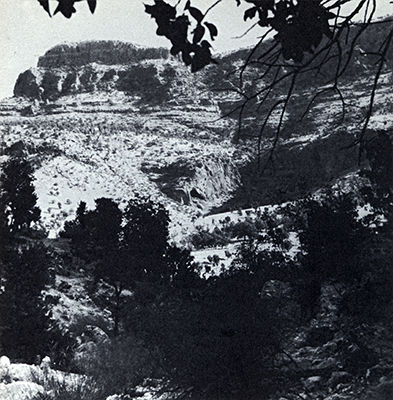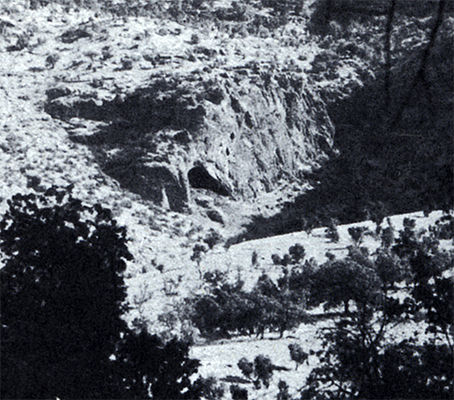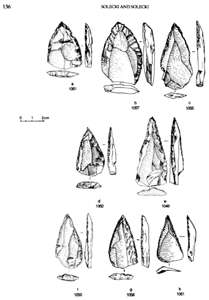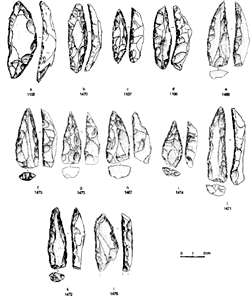Back to Don's Maps
 Back to Archaeological Sites
Back to Archaeological Sites
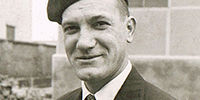 Back to Shanidar Index Page
Back to Shanidar Index Page
Shanidar, the cave in Iraq with Neanderthal remains discovered by Dr Ralph Solecki
Photographs and text are primarily from Dr Ralph Solecki's book, 'Shanidar: The First Flower People' 1971, (unless otherwise attributed) and are used by kind permission of Dr Solecki.
The basis for The Clan Cave in the book by Jean Auel
The cave site of Shanidar is located in the Zagros Mountains of Kurdistan in Iraq. It was excavated between 1957-1961 by Ralph Solecki and his team from Columbia University and yielded the first adult Neanderthal skeletons in Iraq, dating between 60-80 000 years BP.
The excavated area produced nine skeletons of Neanderthals of varying ages and states of preservation and completeness (labelled Shanidar I - IX, or Shanidar 1 - 9). The tenth individual was recently discovered by M. Zeder during examination of a faunal assemblage from the site at the Smithsonian Institution. The remains seemed to Zeder to suggest that Neanderthals had funeral ceremonies, burying their dead with flowers, and that they took care of injured individuals. One skeleton and casts of the others at the Smithsonian Institution are all that is left of the findings, the originals having been dispersed in Iraq.
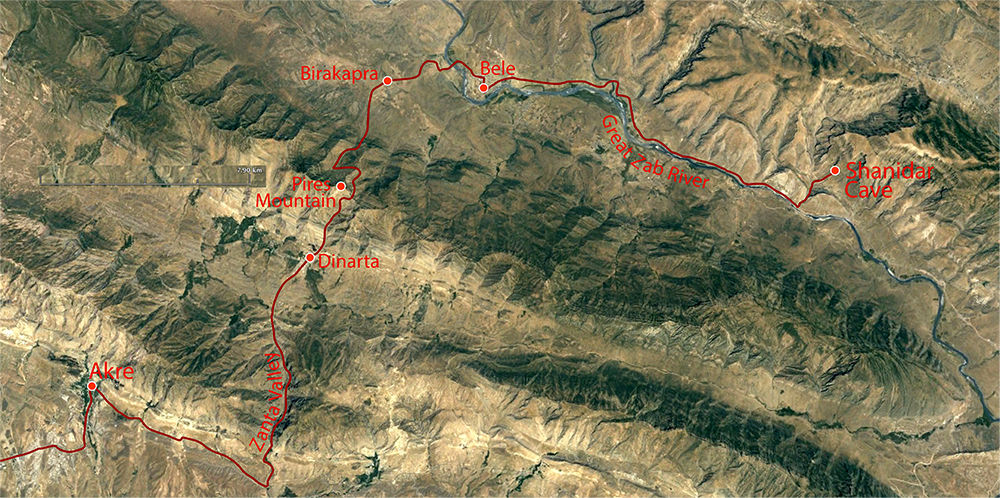
Route across the mountains from Akre/Aqra to Shanidar cave, taken by Dr Ralph Solecki and his interpreter and assistant, Mr Mahmoud Khudhir Sulaiman.
For further information about the hazards of this difficult route, see How Ralph Solecki and I discovered the Neanderthal Skeleton
Photo: Google Earth
Route: Don Hitchcock 2016
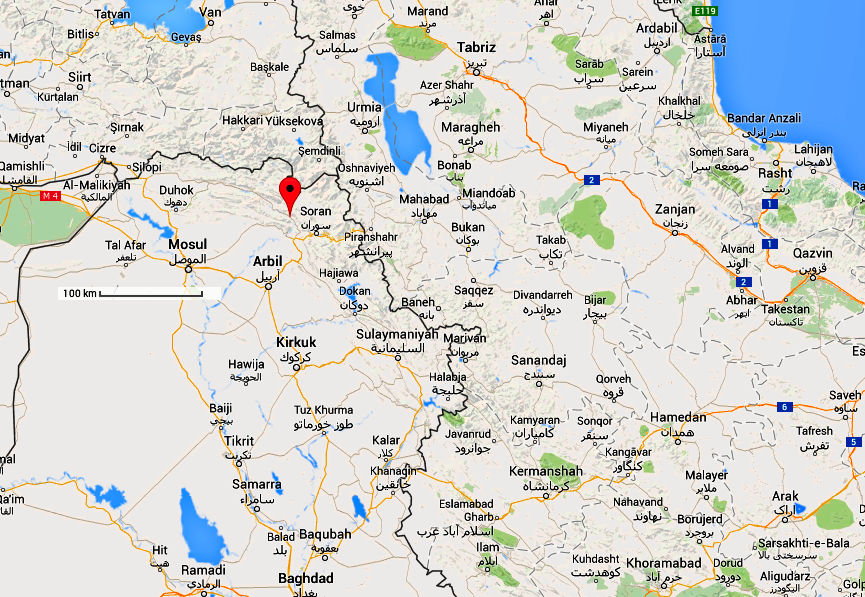
The location of the cave. In recent years it became impossible to visit the cave, because of political unrest in the area, however the situation has now eased, and scientific research is again being undertaken there, as of 2016. It is in Iraq, 500 km north of Baghdad and 100 km north east of Mosul.
Photo: Google Maps
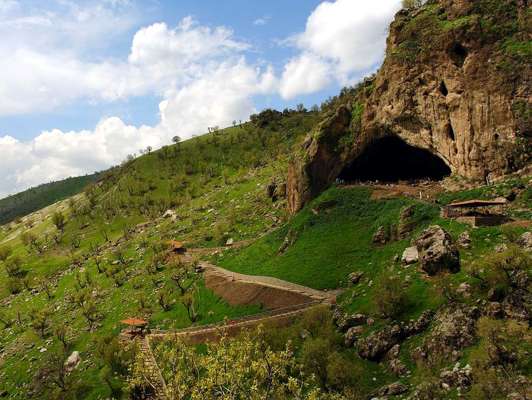
Shanidar Cave
Note the improvements in access shown in this photograph compared with others at the time of the discovery of the Neanderthal remains by Dr Solecki.
Photo: James Gordon - Creative Commons Licence, http://flickr.com/photos/jamesdale10/2331286087/`
From Wikipedia:
The cave site of Shanidar is located in the Zagros Mountains of Kurdistan in Iraq. It was excavated between 1957-1961 by Ralph Solecki and his team from Columbia University and yielded the first adult Neanderthal skeletons in Iraq, dating between 60-80 000 years BP.
The excavated area produced nine skeletons of Neanderthals of varying ages and states of preservation and completeness (labelled Shanidar I - IX). The tenth individual was recently discovered by M. Zeder during examination of a faunal assemblage from the site at the Smithsonian Institution.
The remains seemed to Zeder to suggest that Neanderthals had funeral ceremonies, burying their dead with flowers, and that they took care of injured individuals. One skeleton and casts of the others at the Smithsonian Institution are all that is left of the findings, the originals having been dispersed in Iraq.
The Clan Cave in the EC series is located on the Crimean Peninsula, but the original was excavated by Drs Ralph and Rose Solecki hundreds of kilometres away in Iraq.
Click on the photos to see an enlarged version
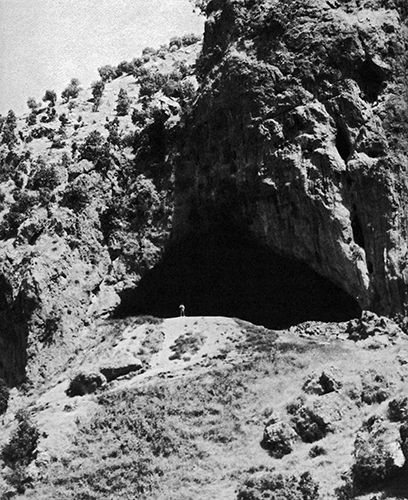
The entrance to Shanidar Cave.
Photo: Solecki (1971)
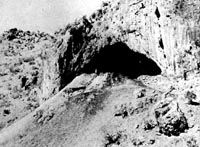
The entrance to the cave.
Photo: Solecki (1971)
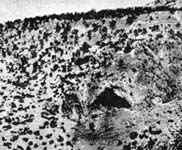
Shanidar Cave
Photo: Solecki (1971)
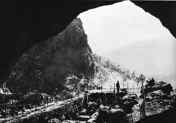
Looking out of cave entrance
Photo: Solecki (1971)
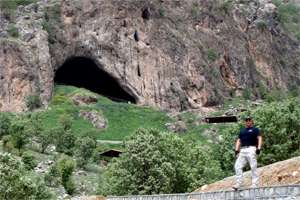
Shanidar Cave
Photo: Hutts, July 2008, at http://www.huttsiniraq.com/Photo%20Gallery.htm

Shanidar Cave
Photo: Hutts, July 2008, at http://www.huttsiniraq.com/Photo%20Gallery.htm
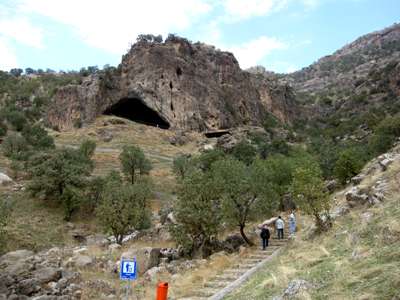
The approaches to Shanidar Cave
Photo: one-thirteen, at http://www.flickr.com/photos/one-thirteen/sets/72157622721849593/
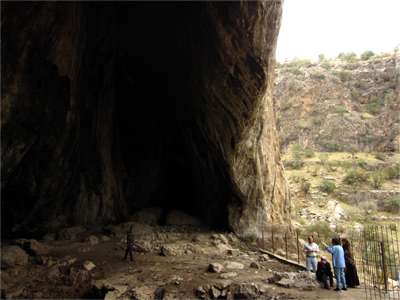
Entry to Shanidar Cave
Photo: one-thirteen, at http://www.flickr.com/photos/one-thirteen/sets/72157622721849593/

Holes in the roof of Shanidar Cave
Photo: one-thirteen, at http://www.flickr.com/photos/one-thirteen/sets/72157622721849593/
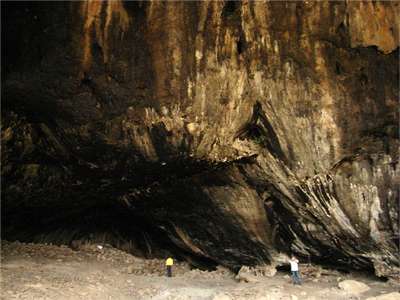
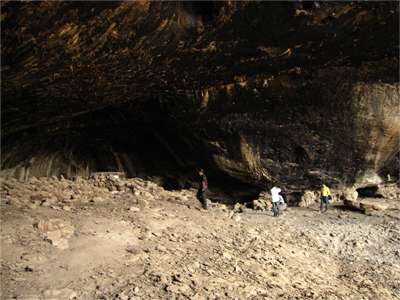
Inside Shanidar Cave
Photo: one-thirteen, at http://www.flickr.com/photos/one-thirteen/sets/72157622721849593/
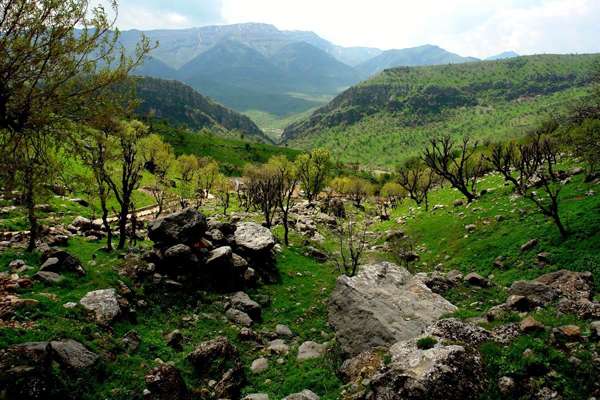
This part of the Greater Zab River valley is called the Sapna Valley. The photo appears to be taken from the walkway up to Shanidar Cave.
Photo: James Gordon - Creative Commons Licence, http://flickr.com/photos/jamesdale10/2331286087/`
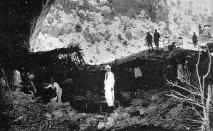
Inside Shanidar Cave
The floor is covered with simple shelters for its Kurdish inhabitants and corrals for their animals. In this photograph Kurdish workmen have just begun the excavation of the earthen floor of the cave. Bedrock was reached at a depth of 45 feet.
Photo and text: Solecki (1971)
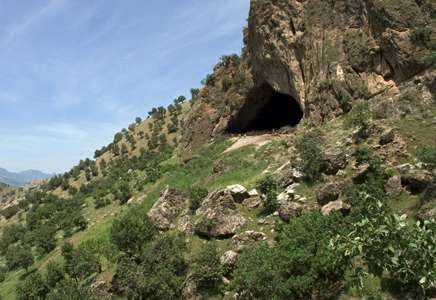
Shanidar Cave
View of the exterior of Shanidar Cave, taken during the summer of 2005. Note for scale the two crouching men in front of the cave. At the time this photo was taken, the interior of the cave was being used as a pen by a local shepherd.
Photo: Wikimedia, originally uploaded by JosephV at en.wikipedia, GFDL licence, released under GNU.

On the way to the Cave - view of Shanidar valley and the Greater Zab River.
The police post is on the terrace edge to right of centre. The sawtooth mountains at the junction of two rivers are at upper right.
Photo and text: Solecki (1971)
(left) Shanidar cave, right centre. Across the middle area is thought to be the old Assyrian road followed by Sargon II on his punitive expeditions against the Kurds.
(right) Close up of the entrance to Shanidar Cave, from the photo on the left
Photo and text: Solecki (1971)
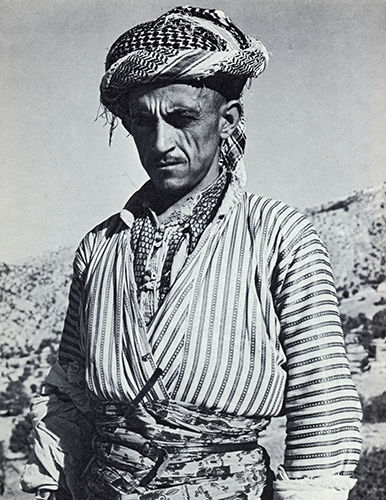
Shanidar village resident, one of our workmen and singers.
Photo and text: Solecki (1971)
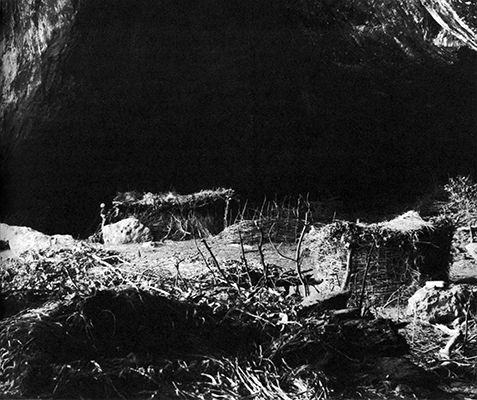
Inside Shanidar Cave, showing the huts of the local inhabitants.
Photo and text: Solecki (1971)
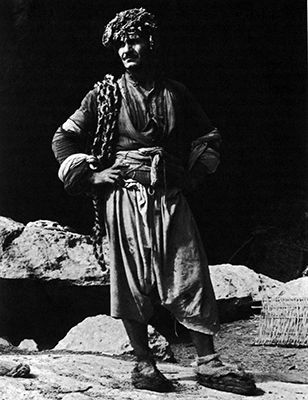
Miroo, one of the few able bodied inhabitants of Shanidar Cave.
The owner of the large house in the cave showed up on October 14, while we were working. Like the rest of the cave people, he belonged to the Shirwani tribe. He was about twenty-five years old, and was called Miroo. Though he stood only about 5 feet 2 inches, he was very muscular and well built.
But he was the most ragged person I had ever seen. He was dressed in a shirt and a pair of dirty drawers which hung down to his mid-shin. A twisted goathair rope was slung over his right shoulder, and on his head was a ragged kerchief. He wore a long undershirt, with the sleeves tied above his elbow in the Kurdish style.
His jacket was of brown cloth, with patches over patches. He wore a standard girdle around his waist. His face was graced with a short mustache and a wispy unkempt matting which looked like a five-day growth of beard on his youngold face. His shoes were worse than those of any of the Kurds with me, just pieces of old rubber tire with ragged cloth attached, held together around his ankles with bits of string. His ragged homespun socks protruded out of these excuses for shoes. No part of his raiment was worth salvaging.
He carried rope and tackle for the donkey, which he had left below, feeding on some grass. From the smiles of my Kurds, they seemed to regard Miroo as a person apart from themselves, or they thought themselves superior to him. He certainly did not care much for the big trench which we were cutting through the floor of the cave. However, he seemed to be good-natured enough, smiling now and then as he exchanged talk with the workmen. After the first brush of meeting, he went about his work. He went back and forth, fetching from somewhere a load of grass which he piled on his house. Although he was dressed in virtual rags, Miroo wore those rags like a robe of the finest ermine. His mien was proudly independent, and he showed it, as though he owned the world. I learned that in the cold winter months from November to April, a group of Shirwani tribal Kurds, of whom Miroo was the forerunner, inhabited this cave.
Photo and text: Solecki (1971)
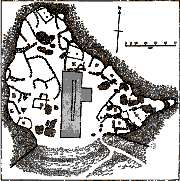
Shanidar Cave Plan
The excavation in the cave is marked in grey. The broken line within it is the first test trench done in 1951.
Photo: Solecki (1971)
From: Shanidar Cave, by Dr Ralph Solecki
The Zagros Mountains resemble the highlands of Scotland; their foothills look like the hills of the U. S. Southwest. Shanidar Cave is in a mountain called Baradost, overlooking Shanidar Valley. From the cave mouth one can see the Greater Zab River, a tributary of the Tigris. The cave, now some 2,500 feet above sea level, was dissolved out of the mountain's limestone rock, originally laid down by an ancient sea. It has a flat earthen floor, about 11,700 square feet in area, and a high ceiling (45 feet at the highest point) blackened with a centuries-old deposit of soot. The Kurdish goatherds and their families, who live in the cave all winter from November to April, have built individual brush huts inside it, each with a small fireplace, and corrals for goats, chickens, cows and horses [see drawing on page 451. The Kurds are a proud, self sufficient, but backward people. They make fire with flint and steel and grind wheat by hand with circular stones. The women cut hay in the mountain meadows with short iron sickles and toil barefooted up a mountain trail with goatskins to fetch water from the springs. Compared with modern Baghdad, only 250 miles away, the present dwellers in Shanidar Cave could just as well be living in the days of the Assyrian herdsmen 2,500 years ago.
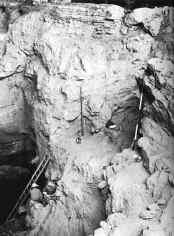
Excavation in the Shanidar Cave. Conditions are obviously difficult and dangerous, and there is a considerable depth of sediments.
Photo: Solecki (1971)
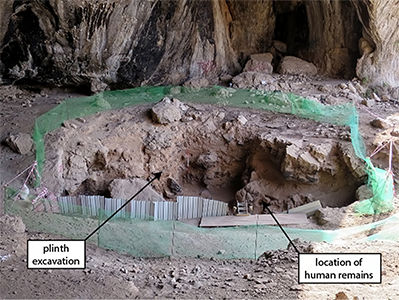
Recent Shanidar excavation, in 2016. Neanderthal remains were found, along with a plinth of sediment, in Shanidar Cave in Iraq.
In a recent article published in the journal Antiquity, a team of archaeologists reported finding additional Neanderthal bones from the Shanidar cave. The bone remains recovered from the area includes a hamate, the distal ends of the right tibia and fibula, and some articulated ankle bones, scattered fragments of two vertebrae, a rib and long bone fragments.
Photo: Graeme Barker
Source and text: https://archaeologynewsnetwork.blogspot.com/2016/01/archaeologists-resume-work-in-iraqs.html#mbwU2DmMwKgAAGhy.97
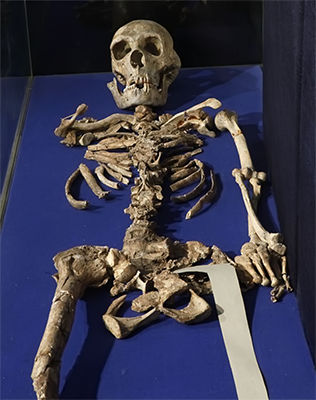
The skeleton of a Neanderthal found at Shanidar Cave, displayed at the Iraqi National Museum in Baghdad.
Photo: Hadi Mizban/PA Images
Source and text: https://archaeologynewsnetwork.blogspot.com/2016/01/archaeologists-resume-work-in-iraqs.html#mbwU2DmMwKgAAGhy.97
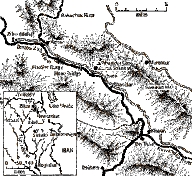
Map of the Shanidar location. The cave is located in Iraq, close to Turkey and Iran. The Clan Cave in the EC series is located on the Crimean Peninsula, but the original was excavated by Drs Ralph and Rose Solecki hundreds of kilometres away.
Photo: Solecki (1971)
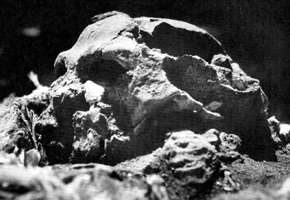
Skull of Shanidar I, the inspiration for Creb in the Jean Auel series.
Skull as it looked when first found, but actually photographed back in civilisation after the protective plaster cast had been removed.
Photo: Solecki (1971) in Trinkaus (1983)
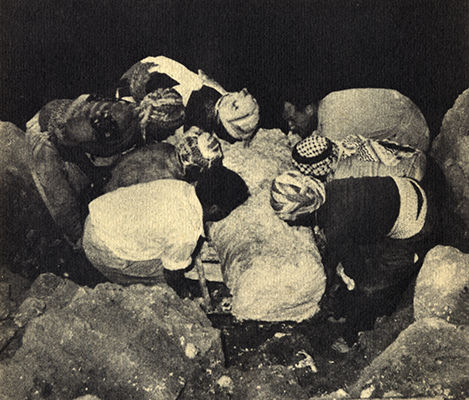
Removing the Shanidar I skeleton encased in a block of plaster of paris.
Photographs such as this took a long time to set up in the darkness of the pit, normally lit only by oil lamps. Magnesium powder was put on a shovel, the camera was made ready, with the shutter open, then the magnesium was lit, and the shutter closed. The photographs came out well, but there were few of them because of the amount of preparation involved.
Photo and text: By kind permission of Dr Solecki
Source: Solecki (1971)

Skull of Shanidar 1
Age: Between 45 000 and 35 000 years old
Species: Homo neanderthalensis
Through examining his skeletal remains, scientists found evidence that at a young age, Shanidar 1 experienced a crushing blow to his head. The blow damaged the left eye (possibly blinding him) and the brain area controling the right side of the body, leading to a withered right arm and possible paralysis that also crippled his right leg. One of Shanidar 1's middle foot bones (metatarsal) on his right foot shows a healed fracture, which probably only enhanced his noticeable limp.
All of Shanidar 1's injuries show signs of healing, so none of them resulted in his death. In fact, scientists estimate he lived until 35–45 years of age. He would have been considered old to another Neanderthal, and he would probably not have been able to survive without the care of his social group.
Photo: Chip Clark, Smithsonian Institution
Source and adapted text: http://humanorigins.si.edu/evidence/human-fossils/fossils/shanidar-1
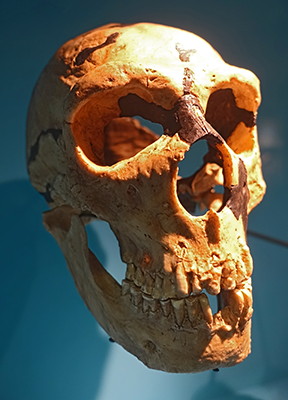
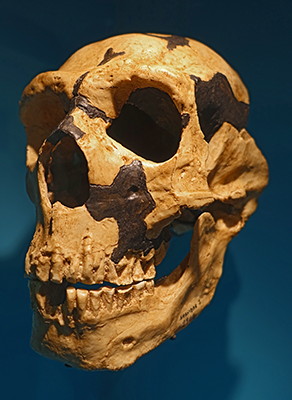
Shanidar 1 facsimile.
Photo: Don Hitchcock 2018
Collections du Muséum national d'Histoire naturelle, Paris
Source and text: Musée de l'Homme, Paris
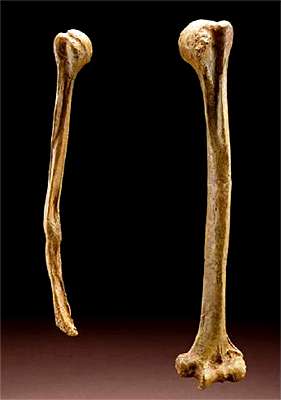
Image of Shanidar 1, Shanidar Cave, Iraq.
Withered right humerus compared to robust left humerus.
Photo: Chip Clark, Smithsonian Institution
Source and adapted text: http://humanorigins.si.edu/evidence/human-fossils/fossils/shanidar-1
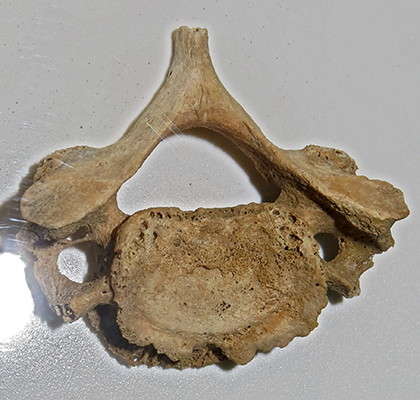
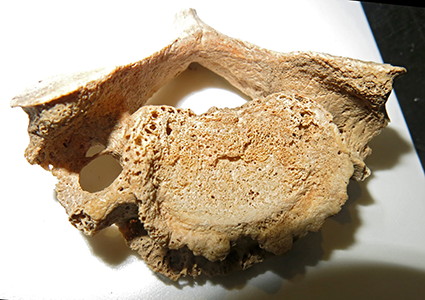
The story of an old man.
In Burial I in the Shanidar Cave in Iraq, a 40 - 50 year old man was buried 50 000 years ago. In the course of his life, he suffered numerous injuries all over his body - and still survived. It was only thanks to loving care from his family group that he reached this relatively old age.
Here we can see arthritic tumours and growths on a cervical vertebra of Shanidar I.
Photo: Don Hitchcock 2015
Source and text: Monrepos Archäologisches Forschungszentrum und Museum, Neuwied, Germany
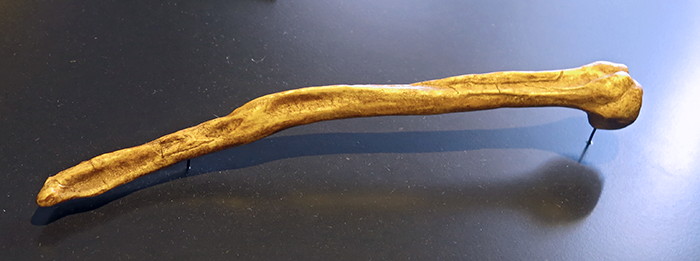
Stunted Humerus of the old Neanderthal man from Shanidar. The arm was already deformed at a young age. The rest of the skeleton is also marked by the dangerous life-style led by the people of that group.
Shanidar, Iraq, circa 50 000 BP.
Photo: Don Hitchcock 2015
Source and text: Monrepos Archäologisches Forschungszentrum und Museum, Neuwied, Germany
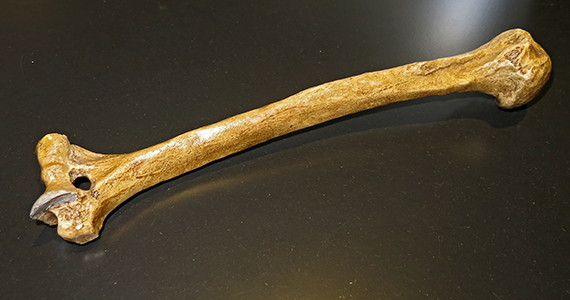
For comparison, the intact humerus of a healthy Neanderthal.
Photo: Don Hitchcock 2015
Source and text: Monrepos Archäologisches Forschungszentrum und Museum, Neuwied, Germany
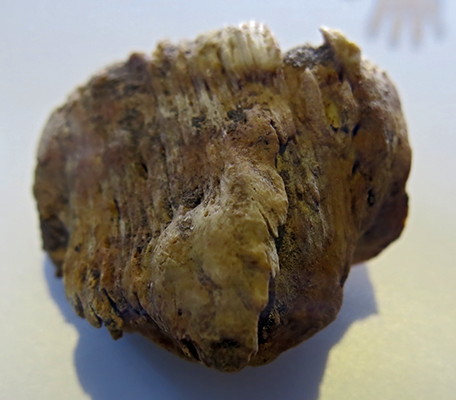
Knee cap (patella) of the 50 year old man with additional ossification due to overload on his one good leg.
Photo: Don Hitchcock 2015
Source and text: Monrepos Archäologisches Forschungszentrum und Museum, Neuwied, Germany
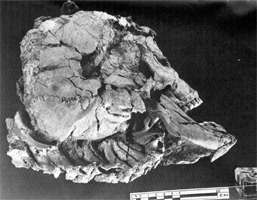

Two views of the Shanidar 2 skull and cervical vertebrae in their crushed in situ position. This was the condition of the specimen after initial cleaning and impregnation in the Iraq Museum and prior to the reconstruction by Stewart.
Photo: The Iraq Museum, in Trinkaus (1983)
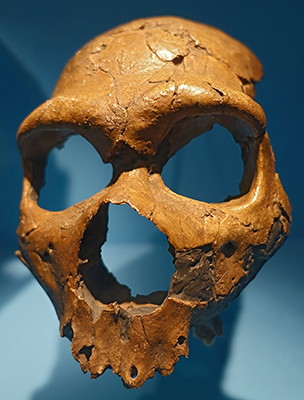
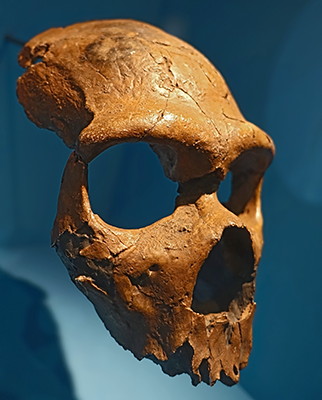
Shanidar 5 facsimile.
40 000 BP - 73 000 BP. The partial skeleton of Shanidar 5 was discovered by a team led by Ralph Solecki in 1960 in Northern (Kurdish) Iraq. The skeleton is speculated to be of a 35-50 year old male.
As with other of the skeletal elements found at this site, the cranium of Shanidar 5 shows evidence of trauma - a 5mm long scar on the frontal bone (anterior of bregma and to the left of stephanion), perhaps caused by a wound to the scalp. The trauma sustained by the several Neanderthals found at this site suggests both an existence fraught with danger and some type of societal altruism.
Photo: Don Hitchcock 2018
Collections du Muséum national d'Histoire naturelle, Paris
Source and text: Musée de l'Homme, Paris
Additional text: © https://boneclones.com/product/homo-neanderthalensis-shanidar-5-cranium-BH-051
Trauma-Related Abnormalities
Text and photographs within these horizontal rules is abridged and adapted from: Trinkaus (1983). This reference is by far the most complete on the Neanderthals from Shanidar Cave, it is a wonderful book which should be on all anthropologists' bookshelves.
Shanidar 1 was one of the most severely traumatised Pleistocene hominids for whom we have evidence. He suffered multiple fractures involving the cranium, right humerus, and right fifth metatarsal, and the right knee, ankle, and first tarsometatarsal joint show degenerative joint disease that was probably trauma related.
The Upper Limb
The preserved bones of the right arm - the clavicle, scapula, and humerus are clearly abnormal at first inspection. They are much smaller than the corresponding bones of the normal left arm. They show a reduction on the right of 10-15% in clavicular shaft size, about 35% in scapular spine height, and about 45% in humeral shaft size. The decrease in clavicular shaft cross-sectional dimensions are relatively uniform with respect to cortical thicknesses and medullary cavity diameter, even though the cortical walls appear to have decreased slightly more than the medullary cavity.
The small size of these three bones was probably due to some form of nerve injury, leading to hypotrophy if it occurred during growth, or to atrophy if it occurred during adulthood. The modest but clear asymmetry in humeral length would be in agreement with either of these interpretations.
In aspects other than its small size, the right scapula appears to be normal. The right clavicle and humerus, however, show additional abnormalities.
The right clavicle exhibits a moderately sized lesion on the superior diaphyseal surface possibly produced by a soft tissue injury adjacent to the clavicle. The latter interpretation is in keeping with the condition of the other arm bones.

Anterior view of the Shanidar 1 right humerus. The head of the humerus has been reconstructed in plaster. Scale in centimetres.
Photo: Trinkaus (1983)
The Shanidar 1 right humerus shows two fractures in addition to its reduction in size. The more proximal fracture occurred about two-thirds of the way distally along the diaphysis. The bone exhibits in the region of this fracture a slightly sinuous curve, which was formed by the deposition of callus and the extensive resorption of diaphyseal cortical bone around the fracture site.
The abnormality was probably produced by a single injury to the diaphysis.
The other fracture of the right humerus was transversely across the olecranon fossa, perhaps at the margin of the distal articular capsule. The distal end of the humerus, as preserved, shows an irregular edge, flattened anteroposteriorly, with extensive exposure of trabecular bone.
Even though the bone did sustain postmortem breakage, as evidenced radiographically, the distal end shows little or no damage. The exposed trabeculae are all rounded and show none of the angular edges associated with postmortem breakage. This irregular end is probably the proximal end of a fracture that did not subsequently reunite. It may be the proximal side of an amputation performed to remove the useless forearm.
Careful examination of the region around Shanidar 1 in Shanidar Cave failed to produce any trace of the right distal arm or hand.
The right arm of Shanidar 1 clearly sustained a serious injury or injuries, resulting in atrophy of the preserved bones, multiple fractures of the distal humerus and osteomyelitis of the clavicle. It is impossible to ascertain in what order these abnormalities developed because all of them occurred long before death.

Shanidar 1 hand.
Lesions on the hands and arms observed on several Neanderthal skeletons from Shanidar, Iraq, resemble those observed on the bones of rodeo professionals, which are due to violent falls.
The dangerous practice of hunting large animals, often in close combat, could explain these injuries.
Photo: Unknown
Rephotography: Don Hitchcock 2018
Collections du Muséum national d'Histoire naturelle, Paris
Source and text: Musée de l'Homme, Paris
The Lower Limb
The right foot of Shanidar 1 and its associated distal tibia and fibula show several abnormalities . The partially preserved left foot, however, is normal, indicating a marked asymmetry in the incidence of these lesions.
The right fifth metatarsal exhibits a well-healed fracture near the middle of the diaphysis. There is a large callus, especially on the dorsal and dorsomedial surfaces, and the fracture produced a slight deformity in the diaphysis. The fracture was probably the product of trauma. The break, once healed, does not appear to have produced a loss of function in the lateral longitudinal arch of the foot. Associated degenerative joint disease may have inhibited movement, or at least made it painful.

Abnormalities of the Shanidar 1 left orbit and femoral condyles.
(a) Anterolateral view of the left lateral orbit, with portions of the frontal, zygomatic, and temporal bones clearly evident.
(b) Lateral view of the distal right femur.
(c) Posterior view of the distal right femur. Scales in centimetres.
Photo: Trinkaus (1983)
The right foot has features which are all indicative of advanced degenerative joint disease. Although advanced degenerative joint disease in the foot may occur as a result of normal but excessive wear and tear, it appears likely that the osteoarthritis of the Shanidar 1 right foot was trauma related.
Not only is it associated with a fracture in the same foot, but the preserved portions of the left foot are normal (Figures 68 and 69). Such a degree of asymmetry in degenerative joint disease in the lower limb suggests that the articular degeneration followed disruption of the normal functioning of the joints by an injury.
A similar development of osteoarthritis can be seen at the right knee of Shanidar 1. In addition, the right patella is considerably wider than the left one, suggesting some remodelling of the bone after the onset of the degenerative joint disease. As with the feet, the degenerative joint disease appears to be unilateral and may well be trauma related.
Associated with these abnormalities of the right leg and foot is a curious curvature of the left tibial diaphysis. Instead of the usually straight diaphysis seen in other Neanderthal and recent human tibial diaphyses, the Shanidar 1 left tibial diaphysis is anteriorly and laterally concave and posteriorly and medially convex.
The diaphysis was damaged postmortem, and some distortion may have been introduced during its restoration; however, postmortem alteration was probably minimal and does not fully account for the curious curvature. Because the preserved portions of the left leg and foot are otherwise normal, this abnormality may have been produced indirectly by the multiple disorders of the right lower limb.
An abnormal gait would alter the patterns of biomechanical stress within the tibial diaphysis and promote remodeling of the cortical bone. If the abnormal stress pattern persisted for a sufficient period of time, it could produce the type of deformity seen here.
The Cranium
The injuries that Shanidar 1 suffered were not limited to his limbs. Traces of past injuries are also present on the cranium. There are healed scars on the external table of the right frontal, in the region of the tuber,
suggesting scalp wounds that damaged the periosteum but did not fracture the
frontal bone.
Even though the internal table of much of the cranial vault was
lost in situ, there is no evidence on the preserved internal surface of the right
frontal to suggest that these wounds affected the cranial cavity.
The primary cranial injury that Shanidar 1 sustained was a crushing fracture to the lateral side of the left orbit, involving the frontal bone and the left zygomatic bone. This fracture healed over during the life of the individual, but it left a permanent deformation to the left side of the upper face.
The lateral margin of the left orbit is flat, rather than being gently convex craniocaudally and anteroposteriorly. The external surface bone exhibits healing from about 10.0 mm above the frontozygomatic suture on the frontal bone and across all of the zygomatic bone. Although the right and left orbit heights are equal, the left orbit breadth is about 8.0% below that of the right orbit, indicating the extent of the medial crushing of the frontal process of the zygomatic bone. The zygomatic bone was also broadened craniocaudally, largely by an extension of the maxillary process along the M. masseter insertion. This crushing fracture must have disturbed the contents of the orbital cavity, probably causing blindness in the left eye. However, the condition of the bone indicates that full healing of the fracture took place long before the death of Shanidar 1.
Diagnosis
The exact interrelationship of these multiple injuries and injury-related abnormalities of Shanidar 1 is difficult to decipher. All of the fractures occurred some time before his death, probably years before, as indicated by the extensive healing and resorption of the calluses.
Even the osteomyelitis on the right clavicle may have been largely healed and in the process of being resorbed when Shanidar 1 died. Yet it should be possible to interrelate these lesions so that they are not isolated entities, each with its own diagnosis.
Three general scenarios appear reasonable.
These scenarios are not intended to be exhaustive of all possibilities, and details could be altered and still fit the available data; they are intended only as the most reasonable interpretations that account for all of the observed abnormalities of Shanidar 1.
Scenario 1
Shanidar 1 sustained a massive crushing injury to the right side of the body, primarily in the region of the arm. and shoulder. A crushing injury, such as a rock fall, is more likely than an incised wound because an incised wound of this degree would probably have been associated with fatal haemorrhaging.
A soft tissue injury would account for the evidence of infection (osteomyelitis) in the clavicle. The fractures of the distal humeral diaphysis and olecranon fossa region would have occurred at the same time, and the pseudoarthrosis/amputation would have developed subsequently. The small size of the right arm bones could be the product of hypoplasia or atrophy, depending upon when the injury occurred; either interpretation of the small size of the bones is consistent with a prolonged period of survival.
The fracture of the right fifth metatarsal probably occurred at the same time as the injury to the right arm. The extensive degenerative joint disease of the right lower limb and the abnormal curvature of the left tibial diaphysis were probably secondary to the trauma, resulting in part from soft tissue injury and in part from abnormal locomotion due to the injury.
In this interpretation, the cranial injuries would be seen as secondary to the crushing trauma to the right side of the body. They may have occurred at the same time from the individual falling away from the blow to the right side and striking a hard object, or they may have happened later as a result of the individual's inability to get around easily.
Scenario 2
The cranial trauma, especially the fracture of the left side of the upper face, could be seen as primary and the damage to the body secondary. The crushing fracture of the left lateral orbital margin undoubtedly caused blindness in that eye; it may also have damaged the left cerebral motor cortex, directly or indirectly through a localised disruption of cerebral circulation. Such an injury to the brain could cause hemiplegia to the right side of the body. It may well have affected the motor innervation to the upper limb primarily, for ¡t is this portion of the motor cortex that is closest to the injured zygomatic bone, and affected the motor control to the lower limb to a lesser degree. The hypoplasia/atrophy of the upper limb would develop directly from this type of nerve injury, and the degenerative joint disease of the right lower limb and the abnormal curvature of the left tibial diaphysis could easily follow partial paralysis of the right lower limb and the resultant abnormal gait.
In this interpretation, the right frontal scalp wound, the osteomyelitis of the right clavicle, the fractures and pseudoarthrosis/amputation of the right humerus, and the fracture of the right fifth metatarsal would be seen as secondary to the cranial injury. Shanidar 1, once weakened by partial paralysis, would have been more susceptible to injury and infection.
Scenario 3
Shanidar 1 was subjected to a major injury to the brachial plexus that resulted in paralysis of the right arm and subsequent hypoplasia/atrophy of the various bones. A traction injury to the brachial plexus could have been responsible, in which case the clavicular osteoniyelitis and the humeral fractures would be seen as having occurred subsequently. Alternatively, a penetrating wound to the shoulder or axilla could easily damage the brachial plexus and cause an infection that would lead to the osteomyelitis of the clavicle. In this case, the humerus could have been fractured at the same time that the shoulder was wounded.
In this scenario, the injuries to the cranium and right foot, the degenerative joint disease of the right leg and foot and the abnormal bowing of the left tibia would have to be seen as having developed independently, either prior or subsequent to the right arm lesions. lf the various fractures are seen as having occurred independently, there are many different sequences that could be postulated.
These interpretations of the injuries to Shanidar 1 are clearly speculative. The first two scenarios suggest interrelationships between the various abnormalities, whereas the third one is more cautious and deals with them separately. The individual injuries are nonetheless obvious, however they might relate to each other.
Degenerative Abnormalities
The few degenerative abnormalities of Shanidar 1 are clearly noticeable, but they appear to be relatively minor compared to his trauma related lesions.
For example, both of the external acoustic meatuses of Shanidar 1 are largely filled with exostoses.
Auditory exostoses are a bony response to irritation of the external acoustic canal, which is age dependent and highly influenced by an individual's life history. They are known in most recent human populations and have been documented in La Chapelle-aux-Saints 1 and even Chou-kou-tien "Skull X". Their presence in the external auditory meatuses of Shanidar 1 is not particularly unusual, especially given his reasonably advanced age.
The rib wound to Shanidar 3
Did we mate or murder Neanderthals?
Aiming his crossbow, Steven Churchill leaves no more than a two-inch gap between the freshly killed pig and the tip of his spear. His weapon of choice is a bamboo rod attached to a sharpened stone, modeled after the killing tools wielded by early modern humans some 50 000 years ago, when they cohabited in Eurasia with their large-boned relatives, the Neanderthals. Churchill, an evolutionary anthropologist at Duke University, is doing an experiment to see if a spear thrown by an early modern human might have killed Shanidar 3, a roughly 40-year-old Neanderthal male whose remains were uncovered in the 1950s in Shanidar Cave in northeastern Iraq.
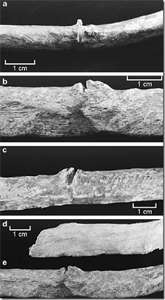
Anthropologists have long debated about a penetrating wound seen in Shanidar 3's rib cage shown at left: Was he injured by another Neanderthal in a fight-or was it an early modern human who went after him?
"Anyone who works on the ribs of Shanidar 3 wonders about this," Churchill says.
Photo: http://www.cbsnews.com/stories/2010/01/07/tech/main6068619.shtml
The possibility that early humans attacked, killed, and drove small bands of Neanderthals to extinction has intrigued anthropologists and fascinated the public ever since Neanderthal bones were first studied in the mid-19th century. At first naturalists were not sure what to make of the funny-looking humanlike bones. But with publication of Darwin's On the Origin of Species, the idea that the bones were from a species closely related to us began to make sense. Eventually scientists recognized that Neanderthals were an extinct species that shared a common ancestor (probably Homo heidel¬bergensis) with Homo sapiens. For thousands of years, Neanderthals were the only hominids living in Europe and parts of Asia.
Then, around 50 000 years ago, early modern humans migrated into Europe from Africa. By 28 000 to 30 000 years ago, the Neanderthals had disappeared.
For more than a century after their discovery, our robust relatives were depicted as dumb brutes, but the Neanderthals have had something of a face-lift in recent years. They are now considered to have been intelligent (as smart as early modern humans, some anthropologists think), perhaps red-haired and pale-skinned, and capable of speech. They might even have created their own language. The more we learn about Neanderthals, the more familiar they seem. But one deep mystery remains: Whatever happened to them, and why did they disappear?
There are many theories but not a lot of proof. That is why Churchill's study of Shanidar 3 and another study published this year about humans cannibalizing Neanderthals are essential. They add a few details to the shadowy picture we have of our long-lost cousins. Anthropologists have many interpretations. Maybe our direct ancestors and Neanderthals largely coexisted (as did many other overlapping hominid species before them), with occasional bouts of quasi-tribal warfare that ebbed and flowed. Then again, maybe humans relentlessly drove Neanderthals into extinction. Right now these are just possibilities. Only the bones and artifacts can tell what really happened.
Churchill's curiosity about the fate of Shanidar 3 led him to try re-creating the sharp, deep scratch in the left ninth rib of this hapless Neanderthal. This strategy actually came from Churchill's colleague John Shea, a paleoanthropologist at Stony Brook University in New York who reconstructs the behavior of prehistoric peoples by analyzing their stone tools. To understand how stone points are worn down when piercing flesh and bone, Shea had run a set of experiments, stabbing goat carcasses and then noting the damage to the tools.
Churchill hoped to compare the cuts on Shea's goat bones to the mark on Shanidar 3's rib. Unfortunately, the goat bones were so damaged by the blows that "it was impossible to analyze them," he says.
He concluded that he would have to do his own experiments to replicate the physics of Shanidar 3's prehistoric wound. Neanderthals were the power-thrusters of the Paleolithic world, driving their heavy spears with great kinetic energy and momentum into bison, boar, and deer. If Shanidar 3 had been injured by such a thrust, it would suggest that he had gotten into a fight with another Neanderthal, or perhaps that he had been hurt in a hunting accident. But if the wound had resulted from a lighter spear-from a projectile deftly thrown at a distance, with less momentum and energy-the attacker was most likely human. There is no evidence whatsoever that Neanderthals ever used throwing spears, Churchill says.
After inflicting a set of sample wounds on pig bones, which are close in terms of size and shape to those of Neanderthals (and which were easily obtained from a nearby slaughterhouse), Churchill and his team of students spent an evening cleaning the bones by boiling them in hot water and Biz, a laundry detergent containing enzymes that are, Churchill says, "really good at breaking down proteins."
The process revealed signs of damage to the pig bones similar to those seen in Shanidar 3. "We cannot definitively rule out accidental wounding, attack with a knife, or attack with a hand-delivered, heavy Neanderthal spear," Churchill says. "But Shanidar 3's wound is most consistent with injury from a lightweight, long-range projectile weapon."
In other words, a human probably did it.
It is impossible to know exactly how major a role human aggression played in the Neanderthals' disappearance. The groups undoubtedly competed for resources, though, and evidently humans sometimes attacked or even ate Neanderthals. The death of Shanidar 3 may thus have foreshadowed the fate of his entire species.
After a human threw a spear into his chest, Shanidar 3 lived at least another two weeks with the spearhead (if not the whole spear) stuck in his ribs. At the time of his death, the gouge in his bone had started to heal. He was one tough guy.
Archaeologists found him some 50 000 years later in the cave in Iraq's Zagros Mountains, buried under the rubble of a collapsed ceiling. There is no way to tell whether he died from his wound or from being trapped under the rock. Like so much else about our wayward cousins, the final cause of Shanidar 3's death remains a mystery.
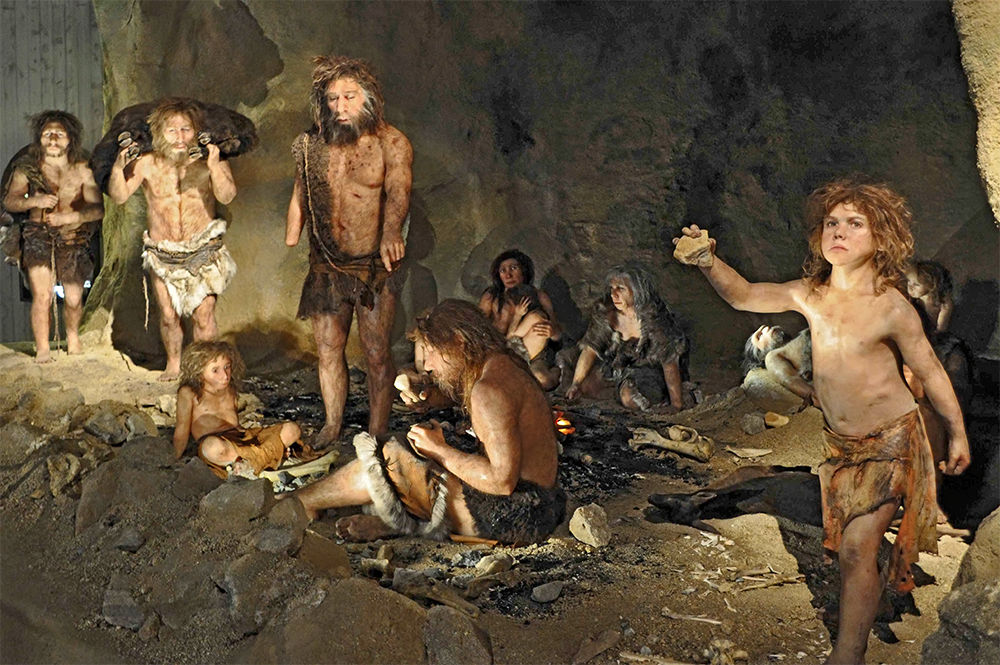
Scene in Shanidar, with some of the people whose skeletons were discovered there. Shanidar 1, with a withered right arm, can be seen at the centre of the diorama.
Photo: https://wonderfuloldthings.wordpress.com/2014/01/28/what-the-shanidar-cave-burials-tells-us-about-neanderthals/
Source: The photograph is of a diorama in the Krapina Neanderthal Museum, Croatia
From Shanidar, by Dr Ralph Solecki:
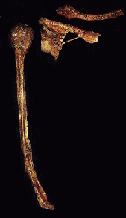 Shanidar 1's atrophied right arm, collar bone, and shoulder blade.
Shanidar 1's atrophied right arm, collar bone, and shoulder blade.
Photo: http://sapphire.indstate.edu/~ramanank/care.html
As we exposed the skeleton there was increasing confirmation that this individual had been killed on the spot by a rockfall. Bones were observed to be broken, sheared, and crushed in place. Some bones were in direct contact with the stones. Various parts of the skeleton had been crushed upon underlying stones of small size. The force of the stone fall seems to have been greatest on the individual's lower legs, his left hip, and the upper part of his chest. It was noted that the left shoulder was higher than the right, and the left hand and arm lay across the chest. Under field conditions the right hand and forearm could not be seen among the remains. Later, in Baghdad, T. Dale Stewart discovered that Shanidar 1, a male, had an underdeveloped right shoulder blade, collar bone, and upper right arm bone. He believes that Shanidar 1 was crippled, with a useless right arm, which had been amputated in life just above the elbow. This discovery was something we had never anticipated in the field identification of the skeleton.
My reconstruction of this fatal accident is that the individual had been killed by a rockfall while he was standing on the sloping cave floor, possibly facing to the east. The fall of stones which struck him was a minor wave of a larger ceiling collapse towards the front of the cave. His body was not completely covered with stones, although the impact was forceful. Fortunately also for the preservation of the remains, the soil absorbed some of the blow. If the stones had been larger or if he had been caught against a solid bed of stones, his bones would have been crushed into an unrecognizable pulp. There would have been little left but a thin phosphate layer for the archaeologist to muse over.
A number of stones must have fallen on him within split seconds, throwing his body backwards full length down the slight slope. Presumably the first stones struck him on the head and across the feet and legs. In falling backwards, his body twisted to the right, pinning down his useless stump of a right arm. His left arm and hand, drawn protectively to his chest, were crushed into his ribs and spine. At the same time, a block of stone severed his head and neck from his trunk, and left them in an unnatural attitude. The lower jaw was dislocated to the front and left side of the cranium and broken against a flat stone. There were a couple of small concentrations of mammal bones in association with the skeleton which might have been rodent nests. But it is equally possible that, these bones were dropped there as part of a funeral feast for the dead.
I believe that the survivors of the rockfall returned, and seeing what had happened, heaped some loose stones, the closest at hand, over the unfortunate's remains. Some of the loose mammal bones lying on top of and among these stones may have been part of the funeral feast. Eventually, a few inches of occupational deposits accumulated over the heap, followed by another rockfall, which sealed off the Mousterian deposit in this quarter. Thus ended a people and an age at Shanidar Cave.
 Part of Shanidar 1's skull, showing the unusual wear on his front teeth
Part of Shanidar 1's skull, showing the unusual wear on his front teeth
Photo: http://sapphire.indstate.edu/~ramanank/care.html
Although he was born into a savage and brutal environment, Shanidar 1 man provides proof that his people were not lacking in compassion. According to Stewart's findings, he was an individual who lived to the relatively old age of forty years, a spry old man for a Neanderthal - equivalent to a man of about eighty today. He was plagued by arthritis, which seems to have been a rather common ailment among Neanderthals - and no wonder, considering the kind of life they led. As a case of rehabilitation, Shanidar 1 was a prime example. Not only did he possess a disability from the day he was born, but he must have been blind in the left eye. Stewart's examinations disclosed that the right arm, collar bone, and shoulder blade had never fully grown from birth. Furthermore, there was extensive bone scar tissue on the left side of his face. And as if this were not enough, there is evidence that the top right side of his skull had received some damage which had healed well before the time of death. In short, Shanidar 1 - or 'Nandy', as we called him around the dinner-table - was at a distinct disadvantage in an environment where even men in the best of condition had a hard time. He could barely forage and fend for himself, and we must assume that he was accepted and supported by his people up to the day he died. Any manpower must have been an asset to this ancient little community, especially since it undoubtedly took group activity to hunt the gregarious beasts of the wild. That 'Nandy' made himself useful around the hearth (two hearths were found very close to him) is evidenced by the unusual wear on his front teeth. It presumably indicates that in lieu of a right arm, he used his jaws for grasping, while manipulating with his good left arm and hand.
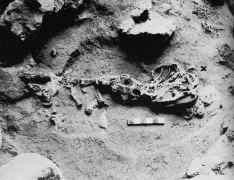
Skeleton of Shanidar I, the inspiration for Creb in the Jean Auel series.
The head was removed first because of the danger of damage while getting at the rest of the skeleton, which involved blasting. The original position of the head is shown with an X. The photo was apparently printed back to front in the text. I have flipped it to agree with the published drawing below.
Photo: Solecki (1971)
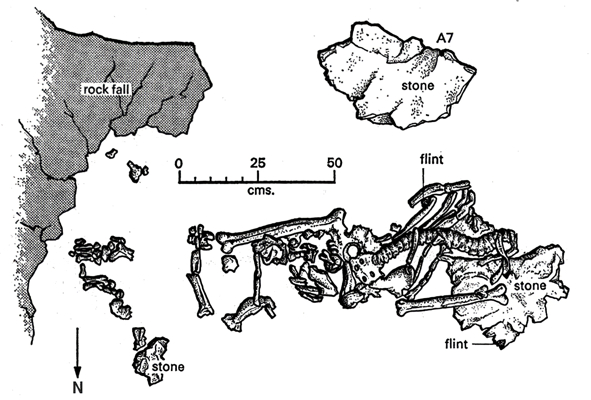
Drawing of the skeleton of Shanidar I, the inspiration for Creb in the Jean Auel series.
The head was removed first because of the danger of damage while getting at the rest of the skeleton, which involved blasting.
Photo: Solecki (1971)
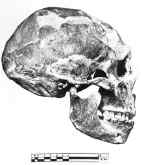
Restored skull of Shanidar I, the inspiration for Creb in the Jean Auel series.
Restored by T. Dale Stewart
Photo: Solecki (1971)
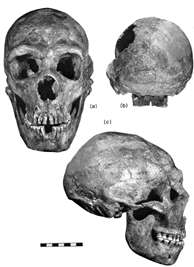
The Shanidar 1 skull in
a) norma facialis,
b) occipitalis,
c) lateralis right.
The mandible has been articulated with the cranium by placing the right premolars and molars in centric occlusion. Scale in centimetres.
(these photos and the images below appear to be of the restoration by T. Dale Stewart - Don)
Photo and text: Trinkaus (1983)
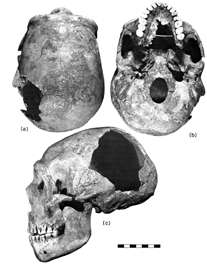
The Shanidar 1 skull in
a) norma verticalis,
b) basalis,
c) lateralis left.
Scale in centimetres.
Photo and text: Trinkaus (1983)

The Shanidar 1 mandible
a) superior view,
b) inferior view,
c) posterior view
Norma lateralis (d) right and (e) left.
Norma medialis (f) right and (g) left
The lateral and medial views are in the planes of the premolar-molar regions and rami.
Scale in centimetres.
Photo and text: Trinkaus (1983)
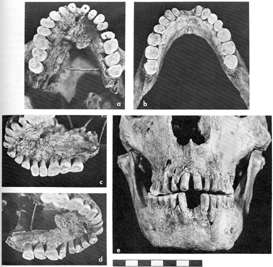
The Shanidar 1 dentition
The I1 were lost postmortem, and the positions of the I1 are approximate due to postmortem damage to their alveoli. Scale in centimetres.
Photo and text: Trinkaus (1983)
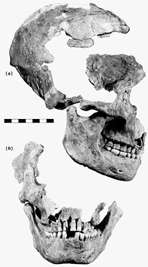
The Shanidar 2 skull in
a) norma lateralis, right, and
b) norma facialis,
scale in centimetres.
The Shanidar 2 skull suffered extensively during its depositional history. It was buried between two rocks, leaning towards its right side, and the two sides were pushed together so that the breadth of the skull was approximately half of its original breadth.
In the process, much of the bone, especially on the left side and along the midline, turned to bone meal and small fragments, thereby making a restoration of the skull to its original shape virtually impossible.
This damage was exacerbated when, after the skull was removed to the Iraq Museum in 1957, a technician soaked the whole skull, in its in situ position, in an acetate chemical. In 1960, when Stewart began the restoration of Shanidar 2, he carefully disassembled the pieces and reassembled those that had reasonable contacts.
Photo and text: Trinkaus (1983)
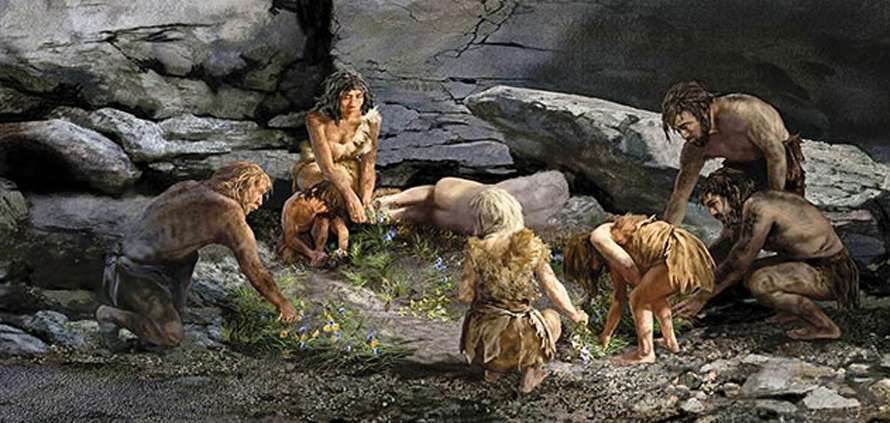
The burial of Shanidar IV, inspiration for Iza in Jean Auel's book "Clan of the Cave Bear"
The skeleton was found buried with many different species of flowers and herbs, evidenced by pollen remains. It was laid to rest sometime between late May to early July. There were at least eight different species of flowers, mainly small brightly coloured wild flowers. There were relatives of the grape hyacinth, bachelor's buttons, hollyhock, and a yellow flowering groundsel. The flowers were probably woven into a pinelike shrub. The most numerous of the flowers were: members of the daisy family, the yarrow or milfoil, St Barnaby's thistle, groundsel, grape hyacinth, joint pine or woody horse tail, and hollyhocks.
Photo: Karen Carr, http://www.smithsonianmag.com/arts-culture/The-Skeletons-of-Shanidar-Cave.html#
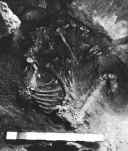
Photograph of Shanidar IV, the inspiration for Iza in the Jean Auel series, soon after discovery, in situ. The (male) skeleton was found buried with many different species of flowers and herbs, evidenced by pollen remains.
Photo: Solecki (1971)
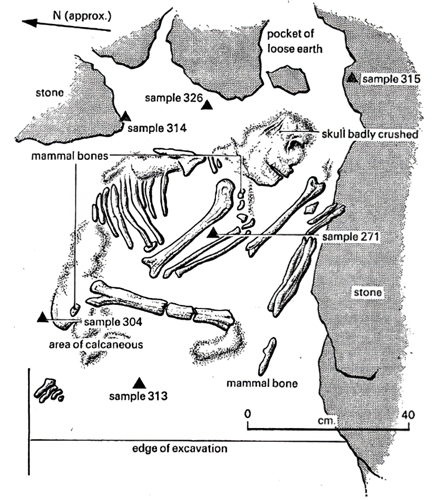
Sketch of Shanidar IV, the inspiration for Iza in the Jean Auel series.
Photo: Solecki (1971)
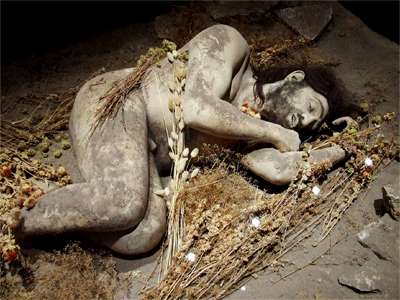
Recreation of Shanidar IV, the inspiration for Iza in the Jean Auel series. The (male) skeleton was found buried with many different species of flowers and herbs, evidenced by pollen remains. He was laid to rest sometime between late May to early July. There were at least eight different species of flowers, mainly small brightly coloured wild flowers. There were relatives of the grape hyacinth, bachelor's buttons, hollyhock, and a yellow flowering groundsel. The flowers were probably woven into a pinelike shrub. The most numerous of the flowers were: members of the daisy family, the yarrow or milfoil, St Barnaby's thistle, groundsel, grape hyacinth, joint pine or woody horse tail, hollyhocks.
Photo: John Connell, Flickr
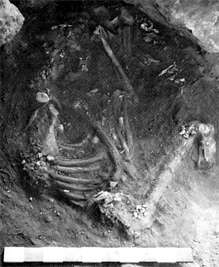
Shanidar 4
The Shanidar 4 partial skeleton in situ in Shanidar Cave. The right scapula, humerus, radius, ulna, ribs, innominate bone, femur and proximal tibia are evident, as are the left radius and ulna above the right forearm bones. The cranium and mandible had been removed prior to the taking of this photograph.
The remains of Shanidar 6, 8, and 9 were underneath the semiflexed remains of Shanidar 4.
Photo: Solecki (1971) in Trinkaus (1983)
Text: Trinkaus (1983)
However, see the following which casts doubt on the flower burial theory:
Doubt thrown on ritualistic Neanderthal burial
See Physical Anthropology, 7th edition, Chapter 14, pages 368-369.
Many investigators of Neanderthal culture believe that the Neanderthals were the earliest hominids to ritually bury their dead. Important evidence that supports this conclusion comes from Shanidar Cave, located in the Zagros Mountains of northern Iraq. Ralph Solecki excavated Shanidar Cave between 1951 and 1960. He recovered Mousterian tools and seven adult and one child burial from Level D. While four of these individuals appear to have been killed by rockfalls, four others may have been deliberately buried.
Soil samples taken around the burial known as Shanidar IV revealed the presence of pollen grains and bits of vegetable matter. While there was very little pollen in most of the soil samples taken around the skeleton, two samples from the burial itself contained a large number of pollen grains representing 28 plant species. This evidence was used to support the hypothesis that more than 50,000 years ago the body was deliberately and ritualistically buried on a bed of woody branches and flowers sometime during the months of May through July, when the flowers were in bloom. The flowers included yarrow, groundsels, grape hyacinth, and St. Barnaby's thistle.
Not everyone has accepted this conclusion, however. The original report reported the existence of rodent holes around the burial along with the remains of rodents of species Meriones persicus or the Persian jird. These animals live in large colonies, and they are known to store large amount of seeds and flowers in their burrows. Analysis of jird burrows has revealed the presence of many of the same flowers that were found around Shanidar IV. Thus the presence of flower pollen around the skeleton may not have been the result of ritualistic activity, but simply the establishment of jird burrows following the burial.
Source: J.D. Sommer, "The Shanidar IV 'Flower Burial': A Reevaluation of Neanderthal Burial Ritual," Cambridge Archaeological Journal, 9 (1999), 127-129.
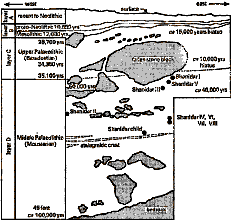
Cross section of the Shanidar Cave.
Photo: Solecki (1971)
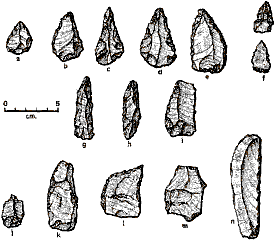
Neanderthal tool kit.
A selection of Mousterian (Neanderthal) tools made of chert, a quartz material similar in working properties to flint, found in the Shanidar cave.
(a-e) Mousterian points on flakes.
(f) Mousteruan point basally thinned on the reverse, or bulbar side.
(g) Thick Mousterian point on a blade
(h) Thick 'limace', or double-ended point on a blade.
(i) Side scraper on a flake
(j) Borer or perforator on a flake
(k) Thick excurvate-edged side scraper
(l) Assymetrically shaped double side-scraper
(m) Residual flake core
(n) Knife with natural back, straight cutting edge.
Photo: Solecki (1971)
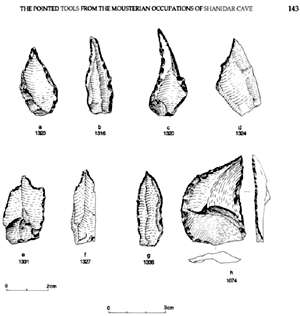
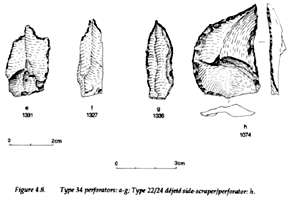
Pointed Tools from Shanidar Cave
Photo: http://books.google.com.au/books?id=blpnUbskCOsC&printsec=frontcover#PPA136,M1
The Paleolithic Prehistory of the Zagros-Taurus: Symposium : Meeting
The pointed tools from the Mousterian Occupations of Shanidar Cave, Northern Iraq.
Ralph S. Solecki and Rose L. Solecki
Text below adapted from: "The pointed tools from the Mousterian Occupations of Shanidar Cave, Northern Iraq."
Ralph S. Solecki and Rose L. Solecki
The collections from the excavations at Shanidar are located in the USA and Baghdad, with the greater part of the collection in Baghdad. (it would be interesting to know the status of the collections in Baghdad after the events there - Don) Layer D is the Mousterian layer at Shanidar. The total floor area at Shanidar Cave is 1086 m2, and the excavations opened a surface area of about 136 m2, an excavation which was begun in the only clear area of the cave floor, the front and central part. There were small uninhabited brush houses and corrals clustered around the interior walls and toward the rear of the cave area. It developed that several families (about forty-five Kurds and their animals) moved in annually during the late fall and winter months to spend the cold season in the cave. It is possible that in ancient times the prehistoric people followed the same pattern as the modern Kurdish peasants, namely, favouring habitation along the interior walls of the cave and leaving the centre and front clear. (thus it may well be that there is much, much more to be discovered at Shanidar - Don)
Solecki spent four seasons at the cave. The excavation was stepped back in depth to minimise the chances of accidental caving in of the walls of the dig. Of the four major cultural horizons, A, B, C and D, more of layer A (Neolithic to Recent) was exposed than Layer B (Proto-Neolithic and Epipaleolithic), more of B than C (Upper Paleolithic or Barodostian), and more of C than D (Mousterian). In this latter horizon, the excavation had a surface area of ca. 112 m2 at Level 14 (3.9 - 4.2 m) at about the boundary of C and D. At about the level of Shanidar Neanderthal No. 1 in Level 15 (4.2 - 4.5 m), the excavation measured 100 m2 in area. At level 19, the excavation measured about 60 m2 in area. At about Level 28, the excavation was a shaft stepped back farther in stages to bedrock at Level 44, ca. 13.4 m. From Level 14 to Level 44, the volume excavated was about 380 m3.
A massive stone block fallen from the ceiling hindered excavation to the north, and massive rockfalls and stone blocks sealed in the deposits to the south. The latter may have been a combination of rockfalls from the ceiling and from the area of the front overhang. From the evidence in our excavation, there appears to have been at least nine major rockfalls during the Middle Paleolithic age, covering a span of an estimated 40 000 years, from 80 000 to 40 000 years ago. We have two dates fixing the upper dates of Layer D, but can presently only guess at the lower limits.
The major rockfalls carried with them a number of uncounted smaller rockfalls coupled with the larger and more massive collections of roof debris. It was evident from the first that these rockfalls had a marked effect on the available living space in the cave. The rockfalls were due to structural weaknesses of the limestone, undoubtedly hastened by freezing and thawing annually, and by the ever present danger of earthquakes. The cave lies near a fault line. It appears that the stone age occupants modified some of the floor area for their living convenience, moving stone blocks and on occasion levelling the floor with earth. One cleared floor area measured 4 x 6 m, and included six hearths. Two portable sized limestone rocks close to one of the hearths exhibited a shiny surface as though from attritional wear on their surfaces. A total of 129 hearths were counted in the Mousterian layer. More than one fire hearth had been down-warped out of shape by rockfalls. The rockfalls also made very effective man traps.
The relatively heavy and numerous rockfalls noted above evidently had a direct bearing on the human occupations of Shanidar Cave.
One of the rockfalls killed Shanidar I and V at about 4.3 to 4.4 m. This rockfall appears to have been the result of a massive ceiling collapse. The probable timing of this rockfall was somewhere between 50 000 to 45 000 years ago, from the carbon 14 datiing.
There are some hints about climate change at Shanidar from the evidence in the sediments. Pollen samples at the 4.5 m level indicate that there was a trend to a wet climate at this point. This was the period in which there was a succession of small as well as large or massive rockfalls. Sediment from the 7.3 m horizon in the upper part of the D4a layer shows a cold and moist environment. There was also a cool climate at 8.3 m and at 8.6 m the climate was wet.
The distribution of the Mousterian pointed tools in Layer D indicated that there was an extraordinarily heavy concentration of these tools in Layer D4.
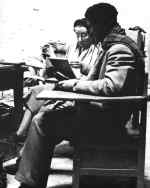
Ralph Solecki, archaeologist and supervisor of the dig which discovered the Neanderthal remains in Shanidar Cave, and author of the book.
Pictured here with Dorothy Garrod discussing the Shanidar Cave finds in the Mustansariyah, Baghdad.
Photo: Solecki (1971)
Interview with Ralph Solecki, published in the Wall Street Journal on 11th July, 2013, when he was 95
In 1950, I was a graduate student at Columbia University. As part of my thesis, I began to explore caves in the Middle East in search of an ideal excavation site.
When I arrived in Iraq's Greater Zab valley in 1950, locals suggested I hike an hour up to the Shanidar Cave. The interior was as spacious as a single-family house—roughly 3,000 square feet with a 20-foot ceiling. The cave seemed ideal for excavation—but first I had to be sure. In '51, I tested soil deposits to see if they contained archaeological material, and they did.
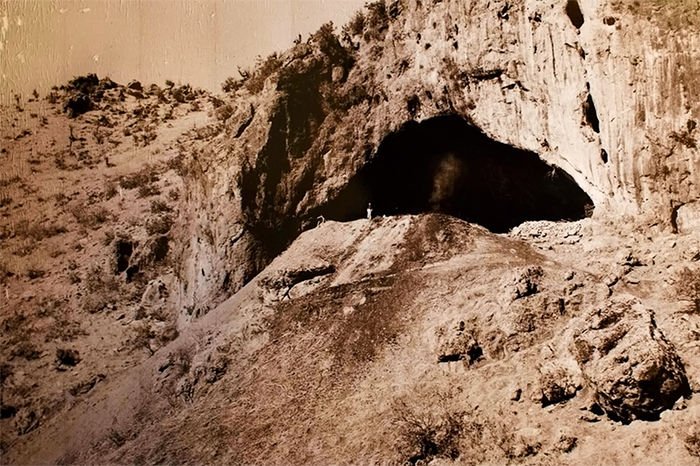
The entrance to Shanidar Cave.
Photo: © John Taggart for the Wall Street Journal
Source: http://www.wsj.com/articles/SB10001424127887323936404578581582780360790
In '52 I continued testing—digging a small hole down about 45 feet to bedrock and sifting the soil. But I had to put my excavation plans on hold in '53. I had started my postgraduate studies, and in '55 I was married. When I traveled back to Iraq in the fall of 1956, my wife, Rose, an archaeologist, accompanied me. While I worked at the Shanidar Cave, Rose excavated a riverbank site in the valley that dated back 10,000 years.
During this time, we lived in a local fieldstone-and-cement police barracks. Our accommodations were spare. There wasn't any running water or toilet facilities, and we slept on cots we had brought with us, covering ourselves with sleeping bags. We had a cook, but most of the food was simple—dried okra, pickles, tinned cheese and meat.
As excavation sites go, the Shanidar Cave had enormous potential. There was a water source nearby, and the cave faced southeast, so when the sun came up in the morning, it heated the space. If there were remains buried in the cave, they'd probably be intact—since they would have been shielded from thousands of years of rain and snow.
I hired a group of about 30 local workers, and we were at the site from 7 a.m. to 3 p.m. each day. We began by digging a 10-by-20-foot hole in the cave's center. Less than two feet down we encountered broken pottery, clay pipes and iron tools. Farther down we found only stone and bone tools.
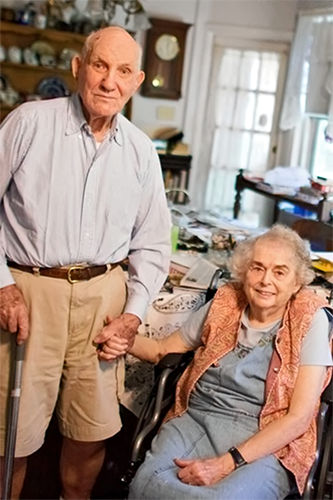
The Soleckis in their home in South Orange, N.J. in 2013.
Photo: © John Taggart for the Wall Street Journal
Source: http://www.wsj.com/articles/SB10001424127887323936404578581582780360790
In the spring of '57, we reached bedrock. I began carefully cleaning the interior walls of the excavation hole with a trowel and brush. I also examined soil strata with a gas lamp to see how they had changed over time. That is when I spotted my first Neanderthal skull sticking out slightly through the soil.
This was a major find because Neanderthal remains hadn't yet been found in this region. After I carefully exposed the skull, I removed it right away so it wouldn't crumble or crack. Up on the floor of the cave, I encased it in burlap and plaster of Paris to ensure it wouldn't shatter. Then we dug down from the surface to expose and excavate the full skeleton.
What we found were the remains of an adult male who was missing his right arm below the elbow. His front teeth were worn—evidence that he had been using them to replace his missing hand. I named him "Nandy"—short for Neanderthal.
Nandy had lived to be about 40, which would have made him roughly 80 in today's years. To survive that long was remarkable. Given his old age and infirmity, he must have been a valued member of Neanderthal society, since they took care of him. He probably had been asleep in the cave when an earthquake struck and a rockfall killed and buried him.
Once we found Nandy, we widened the excavation hole in search of other Neanderthals. Eventually I found another male who had been buried by other Neanderthals and the remains of a third male who may have been killed by an early human rival. When Rose and I returned to Iraq in 1960, I found a fourth Neanderthal with traces of pollen—meaning he had been buried with flowers.
Today, the four Neanderthals' remains are at the Iraq Museum in Baghdad. From the excavation, we know that the region's Neanderthals hunted and took care of their wounded and older members and that they buried their dead. They also used fires for cooking and other social activities.
All in all, Neanderthals did pretty well for themselves considering there were no clothing or shoe stores, hot showers or heating systems. Life was hard 40 000 years ago—which made it tough for Rose and me to complain much about our Iraqi accommodations there.
From Shanidar, by Dr Ralph Solecki:
Page 43
It was an attractive, wild country, wilder than any we had
Page 44
ever seen before on our travels to the Lolan River and to Kaleshin Pass. The craggy, precipitous heights of the Baradost Mountain towered above us all the way. It looked dark and mysterious. The other parts of Iraqi Kurdistan, aside from the Rowanduz gorge area, looked tame compared with this mountain-and-valley province. We found the junction of the Rowanduz River with the Greater Zab River, and compared Hay's description of this region with what lay before us. He called it 'wild in the extreme'.
There were the same shark-toothed line of mountain ridge, the spread of small oak trees and the imposing cliff above that he had described. He mentioned a forest of big oak trees measuring over two feet in diameter, and noted many shrubs and flowers in the region, including 'narcissus, squills, fritillaries and orchids'. The village of Sawer, which he had seen at the junction of the two turbulent rivers, was in ruins.
The people of the area were identified as Surchi tribesmen, who were under the leadership of Haris Agha. Hay gave them a most uncomplimentary description, asserting that they were 'the wildest type of Kurd, rough, savage creatures more like bears than human beings. Of course, Hay's observation was made more than thirty years before us, but nevertheless I felt that he was most unkind to these Kurds. He thought that some of the most savage and uncivilized tribes of Kurdistan lived in the area we were entering. The Surchi, according to him, owned about forty villages, and probably did not number more than 2,500 people. Their holdings stretched along the Greater Zab River to just north of the Rowanduz River. They had suffered extremely during the First World War. He thought that some of the present Kurds must have been Christians at one time, which was a safe guess, since there were Christian villages around Rowanduz. He felt that some of these northern tribes really continued their ancient heathen practices under a 'veneer' of Mohammedanism. Hay paints a rather repellent picture of the Kurds, undoubtedly resulting from his duties as political officer in Kurdistan. He must have been a very harassed man, trying hard to understand them and their unpredictable actions.
Ride to the High Zagros Page 45
We continued on our way to Shanidar, stopping for our bearings on the way, and finally arrived at this village at 5 PM on 10 July. We were well received by the commandant of the garrison, a Corporal Lazar, who was an Assyrian. The concrete police post was like a block fortress. This was malaria country, and several men were down with the disease. On top of it all, two policemen had been killed by Kurds in the area nine days before, and heavy security precautions were being observed. We could not have come at a much worse time.
Shanidar lies within the region characterized as an 'iron-bound untamable fastness - a regular Brigand's Paradise. It is also known as the tribal or asbiret country, or the country of the clans'.
Shanidar village lies like a Shangri-la in a mountain-ringed valley on the left bank of the Greater Zab River, about six miles above the junction of the former with the Rowanduz River. It is about twenty-nine miles by road from Khalifan, on the main road to Rowanduz. Shanidar valley nestles like a self contained physiographic unit behind the second range of the Zagros mountain chain on the other side of the highly productive steppe area.
The valley lies at the turning point of the Zagros arc, where the direction of the range changes from a roughly east-west alignment between Turkey and Iraq to the north-west-southeast trend of a more extended mountain chain which forms the border between Iraq and Iran. Not far to the north of Shanidar valley the highlands of Turkey merge into the westward arc of the northern Zagros mountain ranges.
Shanidar (or Sapna, as it is called on the maps) valley lies at an elevation of about 1,400 feet between the Baradost Mountain (Chia Nivakhin or Chia Baradost) on the north-east and Berat Dagh or Mountain on the southwest. The Baradost Mountain has a steep south-west-facing scarp which attains precipitous elevations along much of its length. The maximum elevation Of the Baradost Mountain is close to 6,8oo feet. There are numerous cavities and caves at the junction of a stronger and a weaker bed of limestone. The mountain also has numerous
Page 46
box canyons leading into its sides. These canyons must have attracted the early hunters for their potential for trapping animals and killing them at leisure. The Berat Dagh, on the other side of the river, devolves in lower elevations to a series of conspicuous sawtooth ranges in the vicinity of the junction of the Rowanduz with the Greater Zab River. The Berat Dagh reaches a maximum elevation of 5,700 feet.
These mountains are parallel anticlinal folds, whose axis dips roughly towards the north-west. They are faulted, or discontinuous in their length, with weak parts in their structure. In these faults streams found their easiest work, and cut channels for the present stream drainage.
With an escort of two policemen Dr Mahmud al Amin and I drove the jeep about eight minutes up the road to a place where we were to pick up the footpath leading to the cave. We found a Barzani boy to guard the vehicle while we were gone, and we set out single file, one of the policemen in the lead, his rifle slung carelessly over his shoulder. We followed a well-travelled stony path.
Mahmud and I found it not too easy to match the quick, sure steps of the policemen, whose feet were encased in a kind of knitted slipper with soles of compressed cloth strips. The path kept going up and up, through wooded glades and open stretches of grassy fields. There seemed to be evidence of an old road along parts of the trail. We later learned that Sargon II had gone through this region on punitive wars over 2,5 00 years ago. We stopped for a brief rest on a shalestone ridge above an abandoned village, called Gundi Shkaft, the 'village of the cave'. There were the stone foundations of about four houses, and a dried-up water source which might have been a catchment basin during wetter weather. The trees were dwarf oaks, stunted by the billhooks of the herdsmen, who fed the leaves to their goats. Looking back over the valley, we could see the police post, the Greater Zab River, and the majestic swing of the Baradost Mountain, which hemmed in the valley from the left. Far in the distance were the sawtooth-ridged mountains which had attracted Hay on his visit to this region.
Ride to the High Zagros Page 47
We kept asking the police how much more we had to walk in the heat. The reply was always, 'Not far, just a little more'. Finally we rounded the nose of the mountain, and there before us, some five hundred feet away, was the cave. It lay a bit more above us, and the trail dipped, then swung to the right, and then went left and upwards to the cave. It presented a huge triangular orifice, with several lens-shaped fissures at the right side. Mahmud and I sat and gawked at it for a few moments.
Because of the heat and the fact that he was not in trim, Mahmud decided to wait it out while I went to the cave. This cave was certainly the best one we had seen in all of our travels in this part of northern Iraq. I must admit that I felt a twinge of excitement as one of the policemen and I approached the cave. It looked bigger and bigger as we came closer. It lay in a limestone formation about one third of the way from the bluff top. Timing ourselves, I found that it had been forty minutes since we had left the car down on the valley road.
My first reconnaissance of the cave left me with a very favourable impression. I spent no more than ten minutes there on the initial visit, making some rough measurements. In this solution cavern I observed that the ceiling was much blackened, as if from smoke. I noted that there was evidence of recent habitation in the cave, and counted a number of small twig enclosures inside it. The floor of the cave was thick with cattle and sheep and goat dung. I surmised that there were at least ten to fifteen feet of deposits of debris at the mouth of the cave. Ashes were present everywhere in thick formation. I estimated that the cave could have housed at least six families, perhaps more, of at least seventy to eighty people. There was a good view from the front of the cave, and I thought I could see down to where the Greater Zab River shimmered in the heat between two bills in the Vshaped opening a mile or more away- Water, according to our police escort, was to be found up the trail from the cave in a spring. I picked up two Potsherds which lay on the talus slope of the cave, and brought them to Dr al Amin for his opinion. He thought that they belonged to the first millennium Assyrian in type, and confirmed my opinion that this cave was the one we had been looking for. The next step was to make a test pit, or 'sondage', in the earthen deposits of the cave.
We returned to the car faster than we had come up. There was a bounce to our steps because we believed our mission to be a success. Corporal Lazar gave us something to eat on our return and insisted that we sleep in his bed. He had a bad leg infection, which I treated with sulfa powder. I also gave him some extra sulfa powder and other medications, plus some fresh bandages for his hurt (it healed rapidly in the next few days). He told us something about the cave. He said that about eighty people had lived there during the last trouble with the Barzanis, or Mulla Mustafa's revolt in 1946. Corporal Lazar had brought them all to the police post at Shanidar from there, along with their sheep, of which they had about two or three hundred. He asserted that Shanidar had been a much larger village before the revolt, with about 150 houses, but at the time of our visit there were only about three families. Corporal Lazar promised to take us boar hunting, which surprised me, as I had originally assumed he was a Moslem. I wondered just how good boar hunting was for non-Moslems in these mountains.
We had to sleep on the roof because it was oppressively hot, even though we were situated above the cool air of the river, which rushed in a continuous torrent below us. The mosquito netting enclosing the bed did not help air circulation, making for fitful sleep.
We exchanged farewells the next day, 11th July, and promised to return. I made some rough calculations about costs, and figured that it would take about three hundred dollars and a truck to do about a month of excavation at Shanidar Cave. I wondered about labour, since I did not see many men around the small village. But I was cheerful in the thought that at last we had found what looked like the ideal cave site.
On the way back we stopped to examine a cave called Shkafta Guran near a village called Konashehora. I made detailed measurements, but could not help but think that it did not compare with what we had seen yesterday. We stopped at
Page 49
another cave called Shkaft Owzen (Cave Good Water) over looking the police post of Khalan. This cave had been used as an animal corral. Dr al Amin remained at the police post during this investigation, while I spent about an hour and a half going, coming and mapping the interior. I had two armed police escorts. Dr al Amin learned that there was supposed to be an inscription carved in the rock near the bridge over the Rowanduz River near the village of Jefferkhan. We picked up an escort of four policemen and went to the village of the headman, Hussein Hars Agha, who was of the Zarzi tribe.They were not on the best of terms with their neighbours, the Barzanis of Shanidar. Our walk to the place of the supposed inscription took about three quarters of an hour, but we found no evidence of writing. Therefore we returned and had tea and lunch with the Agha out on his porch. The qaimaqarn of Zibar, Omar Miran, drove up with his guard in a jeep, and we had more tea. There was some talk about how good their rifles were, and to prove it, a stone about the size of a small suitcase was set up a hundred yards away. This became the shooting target of both the home party and the visitors. As a former infantryman, I was impressed by the snap-shooting exhibition of marksmanship. There was no elaborate using of the sling, digging in of the heels in the turf, holding of the breath and so on.
These people shot their rifles as Kentucky hill people did, casually and accurately. Indeed, later on I was to witness one of our foremen on a grouse hunt shooting at the head of the bird, since a hit in the body would have left little for the dinner table. The Agha of Jefferkhan had fallen on hard times ever since he had supported the government against the Barzanis. We took him with us to Rowanduz. On the way, we met a jeep equipped with a machine gun. This small task force was sent cut to check the report of the burning of wheat fields by the enemies of the Agha. These enemies were presumably the Barzanis.
********
Page 52
Historically the name Shanidar may have come from the name of the Shah Nadir, a prince who had settled around Shanidar about two hundred years ago.
Five years later one of our representatives, Sabri Shukri, received a letter from the Bishop of Aqra giving information about Shanidar. According to him the name should be 'Shanider', a place where a Christian monastery had stood. Indeed, the people pronounced the name 'Shanider', a spelling which appeared on one of our maps. Shuan Agha, the village headman, came around and said that it was true that a Christian monastery or church had once been here, and that his family long ago had been Christians and that there had been a bishop in his family. According to the history of the area the southern part of the Sapna valley on the Greater Zab River had Christian settlements, which is bome out by some of the place names, such as 'Der Tesu'. The confirmatory evidence for this at Shanidar was found during the course of our investigations there.
On one of my reconnaissances around the Shanidar village I noticed that there were two rectangular enclosures for pools cut into the rock below the police post. These had not been used for ages, since they were full of leaves and heavy green scum. They reminded me of small swimming pools. Below Shanidar one of the villagers showed me a large hollow in a rock, which he said had been used in olden times to crush grapes. Both of these lent credence to the probability that Shanidar had indeed been a church or monastery at one time. In the last season, a metal medallion struck in Constantinople in the year AD 500 was found at Zawi Chemi Shanidar, the ancient Shan-idar village site. This, plus the 'Christian ware' ceramics found there, lent more plausibility to the inference of a Christian settlement at Shanidar before Islam took over.
Shanidar lies in an open valley of comparatively rolling land about 3,000 feet wide and fifteen miles long. The Greater Zab River in the vicinity of the village of Shanidar is between 600 and 900 yards wide during periods of moderate flow. The river
Page 53
is entrenched within rock gorges above and below Shanidar Cave. Further upstream the river opens up into a broad valley which extends up to and a little beyond the village of Zibar. Both sides of the river valley are intersected by the courses of intermittent streams and outlets from springs.
Shanidar and Sapna valley had been scheduled to be covered by the impounded water behind the proposed Bekhme Dam, a high dam which was planned for construction below the junction of the Rowanduz River and the Greater Zab River at its breakthrough from the mountains. The flood pool was to extend beyond Zibar village to the north-west on the Greater Zab River, and beyond Khalan on the Rowanduz River, to make a long narrow lake nestling in the mountains. Although Shanidar Cave would not have been directly affected it would have made overland access extremely difficult. It would, of course, have covered Zawi Chemi Shanidar and some of the low-lying caves in the district.
This region of Iraq lies in the belt of about twenty inches of annual rainfall, which falls mainly in winter and spring. Warm maritime air from the Mediterranean Sea swings into the Shanidar valley, controlled by the arc of the Zagros Mountains. This swing appears to conform to the south-east curve of the Zagros-Taurus mountain system, and the isohyets appear to follow the contour lines. Undoubtedly much of the fertility of the steppeland of Mesopotamia is the result of this.
A phenomenon of the Shanidar valley, occurring especially in the fall, is the fogging of the river valley bottom in the early morning. The joining of the two rivers, the Greater Zab River and the Rowanduz River, probably causes this fogging, since the greatest concentration of fog seems to occur at their junction. The police at the Shanidar post said that the Shanidar valley was considerably warmer in the winter than the Mergasur valley to the east, on the other side of Baradost Mountain. Similarly, the Shanidar valley was warmer than the Zibar valley upstream on the Greater Zab River to the north. It was claimed that when snow fell in the other valley regions, only rain fell at Shanidar. This appears to be true of Zibar, which I had occasion to visit after snowfalls. Shanidar Cave lay above the snowfall
Page 54
line, while the rest of the valley lay below it. Continual freezing temperatures set in during the last week of December, and the temperature during July nights was cool enough to warrant bed covering. During August the temperature rose to such a point that we had to sleep on the roof of the police post, but still with light bed covering.
The vegetation of this region is of the mixed woodland mountain type. Trees are more abundant on the borders of rivers and streams, and sparsely distributed elsewhere. The trees grow to about twenty feet. They are closely cropped by the herders, who use billhooks to lop off branches to feed to their goats. I have seen goats climb up the lower, stronger limbs of trees from the side of the hill wherever they can, and feed on the leaves. This is reminiscent of some of the ancient gold figures depicting goats in trees in the southern plains of Mesopotamia. Taller and larger trees were reported to grow on the higher slopes of the Berat Dagh, on the opposite side of the Greater Zab River from Shanidar. The predominant tree in the vicinity of the cave was the dwarf oak (Quercus aegilops), which is called by the Kurdish-speaking people dar gholu. This tree, which constitutes the type of vegetation known as maqui, is adapted to and lands in the region east of the Mediterranean Sea. Its fruit is an acorn called balot by the local people. This is an edible nut, better-tasting after treatment. It measures about 1.8 inches in length and about 0.7 inch in diameter. It may be pared easily with a knife. I have seen the local inhabitants of Shanidar Cave pounding this nut into a mealy substance in a deep stone mortar with another stone. This meal was then prepared into a tasty dish. Roasted on an open fire, the nut tasted like a chestnut.
Like all people living close to the soil, the Kurds are good botanists. They were able to identify and name all of the edible types of roots, tubers, nuts and berries which they collected in season. There was a kind of thistle called khangier, a spiked plant, which was also said to be edible.
In my season at Shanidar the most conspicuous flower was the red anemone, called by the Kurds kurek, or kurek nesan. Hay mentions that this flower occurs in mauve, white and crimson. He counted thirty
The First Test Trench at Shanidar Cave Page 55
varieties of flowers one day near his house. These included the scarlet and yellow ranunculus, several kinds of iris, the grape hyacinth, hollyhocks in two colours and the poppy. Up in the higher hills are found acres of narcissi, violets, buttercups, orchids, tulips, roses and tiger lilies. There is hardly a single traveller who does not come away amazed by the widespread covering of flowers.
On 5 October I found myself seated as Corporal Lazar's guest at breakfast across from a local sheikh resplendently dressed in a copper-hued suit, with a gold-studded dagger costing $125 thrust into his sash. Next to him was another breakfast guest, a rather damp, strange Kurd, a Zubari. He had swum across the Greater Zab River with a cargo of wood and grapes. To float his goods across he had used gourds, while he pushed from behind using his feet as propellers.
The same day, we went to the district seat, Zibar, up the road, in order to inform the officials that we had arrived at Shanidar, as protocol demanded. The country was very beautiful, with tall poplars fringing the river, and mountain-ringed valleys and water everywhere. Zibaf impressed me as a rather miserable collection of houses. By actual count, there were about fifty houses in the village, at least two tea houses and some six or seven stores on a single dirt main street. The most prominent fixture there with any appearance of solidity was the police post, which seemed to be built on exactly the same plan as our Shanidar fortress. In fact, all of them in this north country seemed to have been cut from the same kind of mould, as if a giant cooky-cutter had been at work. There was some rubble standing next to this fort, which I was later told belonged to the original Zibar fort. This structure had been destroyed by the cannon of Mulla Mustafa only six years before, in the 1945 rebellion. He had taken aim from across the river and blown it up. Behind the fort there was a flat grassed-over space which I was told was an old airfield. Indeed, I could still see whitewashed strip markers in the field, and the remnant of what looked like a large white circle in the centre.
*****************
Page 60
A full meal consisted of rice, boiled chicken, and a tomato soup, with side dishes of vegetables in season. Leban or a watered yogurt, was generally on the platter with plenty of a very fine unleavened wheat bread, which appeared as a large, flat disc, like an enormous tortilla. All was washed down with several glasses of sweetened tea. A meal generally consumed the better part of two hours. I ashamedly learned later that my meals were princely compared with what the ordinary person or farmer had to eat.
Towards bedtime I was shown to the police post, which was to be my home at Shanidar on every later occasion. The police garrison was built in 1947; at least this legend was scratched in the concrete next to one of the embrasures. The room I was in was about fifteen feet square, with a ceiling about fifteen feet high. There was a lone window high up in the wall towards the outside, well above the height of a man. On the courtyard side of this Beau Geste-like fortress were a simple wooden door and a window. In the centre of the courtyard were feeding troughs and watering troughs for horses. The largest room in the place, about forty feet long, was a horse stable, which must have held at least forty animals. The main entry was through a large double doorway of iron, in which a smaller access doorway had been cut for convenience. A guard stationed himself nightly at this doorway with a lantern and a rifle. An Iraqi flag fluttered bravely above the parapet in front.
The floor in my room was of bare concrete. The rough-and-ready furniture consisted of a small unpainted wooden table and a creaky chair. My two foot lockers full of equipment and miscellaneous gear were ranged along one wall. On the other side were my camp cot and sleeping bag. Of course there was no electricity here, and light was furnished by a kerosene lantern. I took the temperature at 10 Pm, and found that it was 73 degrees F., not too hot to sleep indoors.
The next day, 6 October, I had to leave with one of the Kurdish policemen for Erbil to see his little son, who had only two days to live. A wire had been received during the night, and Corporal Lazar asked me to drive the poor father to the main road. I did this before breakfast. Radio contact was made
The First Test Trench at Shanidar Cave Page 61
with the commandant of the district at Mergasuf, just two hours straight over the mountain to the east of us, concerning an escort for me to Shanidar Cave. The orders came back that I should have three or four police. We all loaded into the jeep, with a Barzani porter to carry my equipment.
We took the same path we had taken on the original trip, and I made some observations.
Shanidar Cave, or Shkaft Mazin Shanidar (Cave Big Shanidar), is situated near latitude 36 deg 50' north, and longitude 44 deg 13' east. It is at an elevation of about 2,400 feet above sea level. The cave is reached by an ascending footpath from the road about 900 feet below. It takes about forty minutes to make the long climb from the road to the cave, and only about thirty-three minutes back.
I noted some original hay ricks up in the tree boughs. The peasants had cut grass in the fields and had placed it up in the forked branches of trees, well out of reach of the goats, who were practically tree climbers. The path to the cave rounds the nose of a jutting ridge, and suddenly it comes to view. The cave has a fine southern exposure, with the sun shining into it the greater part of the day. There is more than ample protection from winter winds. A large bluff protects it on the northern side, matched by another projecting bluff on the south-cast side.
The cave lies in Cretaceous dolomitic limestone, probably of the same formation as that of the Baradost Caves identified by Dennis Batten. It is called 'Qamchuga limestone of Middle Cretaceous age' by the Iraq Petroleum Company geologists. The colour of the rock is a light grey-brown, which erodes into a reddish-coloured soil. There is a fault zone near the cave, parallel to the axis of the mountain folds. An intermittent stream flows at the foot of the slope to the west of the cave. The bed of this stream contains stagnant pools in its lower Portion during the summer months. During the rainy season a torrent flows through it. A path follows the upper reaches through a steep valley to Mergasur, the village on the east side of the Baradost Mountain. It takes about two hours to make this journey. A closer supply of water is up the hill some 410 feet by a well-travelled path. The women of present
Page 62
cave-dwellers carry water in goatskin bags on their back, as their forebears had probably done before them at Shanidar.
The cave mouth is shaped roughly like a broad triangle. The opening measures 82 feet wide and 26 feet high. Not far from the opening the width increases abruptly towards the interior to an extreme of 175 feet. The ceiling vaults loftily to a jagged crevice about 45 feet from the cave floor. From this point inwards the ceiling falls away rapidly to a height of 25 feet, then gradually slopes to the rear until the end of the cave is met, some 130 feet from the cave mouth. The slope in front of the cave, with its annually mounting debris, is steep, slanting away to the gully about 140 feet below.
The floor of the cave was littered with straw, and much sheep, goat and cattle dung. The whole cave had a dusty aspect, with little pools of dust swirling in the sunshine. As much as one can see of the ceiling was darkened by soot. Towards the rear of the shelter where the houses were situated black soot hung down from the ceiling in giant threads and cobwebs. I measured a point of the ceiling at 57 feet with my camera range finder. Bird feathers were to be seen everywhere, and swallows darted about throughout the day, whirling and flying here and there and calling to one another.
I spent the greater part of the day in surveying the cave interior. From its floor I collected a number of items, which included two stone pestles and mortars, two broken pottery jars, one worn-out basket and one hand broom of twigs. I proceeded to photograph these items, while the police stood around and watched me in baffled silence. I caught one policeman grinning at another. The corporal and one of his command went up to the spring for a spot of hunting and water. My Barzani porter also went up the hill somewhere for a drink of water, and returned in an hour. With the help of one of the policemen, I began to survey the interior of the cave, measuring all of the buildings and features of interest I could see. I made an intensive examination of the debris on the slope in front of the cave, in order to find telltale clues of palaeolithic occupation. The net result was one flint of mottled black colour with translucent grey edges. It had some curious wear on the edges,
The First Test Trench at Shanidar Cave Page 63
which looked attritional. I showed it to the Barzani, whose face lit up in immediate response. He recognized it as a strike-a-light flint, or what the Kurds call a berdeste. He produced a small piece of wrought iron from somewhere in his waist, and proceeded to strike at the flint, producing sparks. Returning my flint, he dug deeper into his waistband and his hand came out with his own strike-a-light flint, which looked like a much abused artifact. This was absolutely new to me, since I had not realized that strike-a-light flints were still in use here.
On another occasion one of my workmen showed me how he made fire with his flint and iron. He put a fragment of of punk or pulverized cloth on a piece of flint. The punk was about an inch long. He held the punk on the flint under his thumb, and struck the flint sharply with a stroking motion of the small iron bar. The punk began to smoulder on the flint immediately after a hot spark had touched it. He blew vigorously on the spark, which lit up and burned a dull red in the punk. I watched him light his cigarette, then pinch the spark out of the punk, to be reused next time. He carried the bar of iron, the flint and the punk inside a little tin somewhere in his waist. For him this method of lighting was less costly and troublesome than matches or a lighter.
We later learned that the cave was partitioned off into ownerships, and that six families had an interest in the cave. one of our rock-breaker families' share was destined to become the bottom of the pit. The cave was once owned, according to tradition, by Khuder Agha from a village called Korka near Mergasur. The wily Khor Pasha of Rowanduz was supposed to have taken refuge here with his army. The Turks, met him in battle in this area. They blasted into the cave with cannon, and the men of Khor Pasha fought back with flintlock rifles. Indeed, this was not the last time that the cave had been used as a refuge. Hinting at a more recent cannonade was the discovery of fragments of artillery shells in the excavations. There was some corroboration, for a few chunks of stone had recently become dislodged from the ceiling, as indicated by the bar, white patches in the soot-blackened expanse. There was a tar deposit about one sixteenth of an inch thick on some of the
Page 64
stones. The tar or blackened discolouration had seeped into the cracks on one sample to a depth of about three quarters of an inch. The whole ceiling was covered with a hard shiny substance, which I presumed to be sintef, or limestone percolation.
The earth inside the cave was fairly dry and dusty, with at least one major drip spot towards the rear. Habitation huts, animal stalls and corrals were ranged all around the side of the interior; these I measured and plotted on my chart. The corporal told me that their owners would be coming back to live in these houses in about five days' time. One of the policemen, observing my interest in the debris around the place, very helpfully collected several more items for me to record. These things included three canes with steam-curved handles made of a special scented wood which was supposed to be a snake repellent; one half of a beef bottle; one iron water tank, undoubtedly of military origin; two wooden paddles; two wooden baskets; two broken loop-handled pottery jars; one bay sickle with a wooden handle; one 'shillelagh' club; one rope hitch of wood; and one hollowed-out knot of wood. I photographed all of these dutifully, with the policemen amusedly looking on. I also observed a miscellaneous collection of discarded rags and clothing, worn-out slippers, and on the cave slope outside found some broken crockery and several large and small animal-bone fragments. Down in the gully in front of the cave were the jawbones of at least two or three cows. All this while, swallows and other birds kept darting in and out of the cave, flying through holes to the left of the cave entrance.
Corporal Lazar told me that the people of Mergasur, who were returning to live at Shanidar, had no caves in the Mergasur valley. There were five of six caves in the Shanidar valley which were occupied by the Mergasuf people during the winter months. At the first break of spring they went back to their more open homes.
On the return to Shanidar we passed by the small abandoned settlement of Gundi Shkaft, which we had seen from the ledge above it on our first trip to the cave. One of the people of this village had killed a policeman, and in punishment the village was disbanded. The Shanidar police were Kurds, but from
The First Test Trench at Shanidar Cave Page 65
different areas, not from Barzan. They were paid about $25 a month, although a raise in pay was promised them. The corporal was especially looking forward to the increase because he wished for a wife badly. His first wife had died, and he had a twelve-year-old daughter. One Kurdish father had offered him a wife for 35 dinars ($98), which he could not then afford.
At Corporal Lazar's house I was treated to an evening of song. He sang Barzani songs, holding the palm of his hand to the side of his face, singing in a kind of high-pitched though powerful, resounding voice. As usual, the corporal had guests. On this occasion they included the radio operator, a local Barzan village boy, and one of the policemen. Light was provided by the fire and a flickering kerosene lantern.
On one Friday, our day of rest, we went on a fish-bombing expedition. We took with us three young boys who had stripped down to their shorts. They carried gourds to swim with. The whole troop went in two jeeploads to a point above the Raizan bridge on the Rukuchuk River at Khor Pasha's ruined bridge. We could see great carp slowly swimming around under the modern iron bridge. A home-made bomb made of a beer bottle with sand for weight was thrown in among them. Gunpowder was used for the charge, and a cartridge connected with a short fuse was used to set off the charge. The water rose up and bubbled violently. One large carp floated up, its white belly uppermost, dead from the concussion. One of the boys jumped in and retrieved it. It was a magnificent fish, measuring nearly three feet long. But this method was the only one they seemed to use in catching fish. I never saw a fishing rod or fish weir or net among the Kurds. They seemed to shun fish, and never ate snails, shellfish or turtles, so far as I knew.
I enjoyed the scenic walk to and from the cave. One morning we encountered a goatherd dressed in a felt cloak, the first I had seen worn in the north. His charges jumped around nimbly. Generally throughout the day one heard the long halloo of one person calling to another in the valley, or across from mountain to mountain. Sometimes there would be a song in the fields. Aside from these evidences of inhabitants I was struck by the general lack of people around Shanidar. It seemed to me that
The First Test Trench at Shanidar Cave Page 66
this fertile valley offered the potential to support more inhabitants than there were. Actually, people drifted back during the next season.
There was enmity between the Kurds on our side of the river and those on the opposite side. They belonged to different tribes, and were difficult to bring together in peace. There was a huge white-and-black shaggy dog at Shanidar which was called 'Kazhoo', the name of an agha, or headman, across the river. Such things as this did not make for cordial relations. The different tribes had sometimes waged secret war on each other by such methods as burning wheat crops.
One evening, when I went down from the police post to the village to inquire about hiring more men for my test sounding, I witnessed a strangely haunting scene. On a bluff overlooking the river and facing downstream in the gloom, was a barefoot young girl chanting. She was about twelve years old. She was on her knees, singing to herself in a kind of low plaintive cry. I asked my companion, Nuri, the radio operator, what she was doing. He was silent for a moment, and then, his face visibly disturbed, whispered that her mother had died about three years ago, and she was still in mourning. There was nothing more to say, and I left.
On 9 October I began excavation with one man, my Barzani porter. He began in the forepart of the cave with a test trench. He had to dig through the hardened crust of cattle, sheep and goat dung, and the dark soil of the recent occupations at Shanidar Cave, raising a lot of dust. The trench measured about 10 feet long by 2 feet 6 inches wide. The first materials found were three potsherds. During the lunch break I went up the mountain path to see for myself where the springs were. After just fifteen minutes of winding up a well-beaten path, the police escort and I came to a nest of three pools of water in a copse of blackberry bushes and tall reeds. My escort said that from here there was no path to the top of the mountain. I noticed some small hoofprints near the spring. These may have been made by ibex. Since I did not see any potsherds on the path to the spring I surmised that the cave inhabitants had used skin bladders or skins of whole sheep or goats as water containers. This guess was correct, as was borne out later on when the cave people came to live at Shanidar.
We left late in the afternoon. On the way down we came upon about a dozen tusked wild boars as big as any I had seen. They rushed headlong up the hill. In the excitement of the chase I grabbed a rifle from one of the policemen and ran after them. But the animals got away too fast. I did not know what I would have done with one if I had shot it. Presumably the police, who were Christian, would have eaten the flesh, but I cannot be sure, even now.
On the following day I augmented the digging crew with four extra hands from Shanidar village. I put them to work enlarging the test trench. We were somewhat soaked from the intermittent rain which was now falling day and night. The test trench was enlarged to 28 feet in length. Digging in the trench was made difficult by a number of large rocks which must have fallen from the ceiling. We had gone down to 5 feet, finding pottery, cracked bones and similar recent material in the soft dark-brown soil. The workmen were not very energetic. Some would work while others would stand and look on, reversing roles as it pleased them. I found that they needed a foreman. The tools they had brought to work with were so much junk, and I wondered how they could make much of an impress in the soil. All the shovels had loose handles and were made of a weak kind of sheet metal. We were progressing slowly in the trench. It was stratified, that much was certain. At the 5 foot depth we had reached we found layered deposits of ashes and charcoal with bones and pottery.
My workers came to the excavation fully dressed. But on the job, some took off their socks and sandals or other footgear, and one or two took off their pantaloons and worked in their long underdrawers. The men appeared in a variety of footgear, as the market produced it. It reminded one of the fads in dress at home. At one time there was a flurry of cheap knee-length rubber boots, then rubber shoes which looked like patentleather pumps appeared, complete with fake shoelaces, and a variety of rubber-tyre slippers. None of these were good, particularly not the rubber shoes, which were very hot.
**************************
Page 94
.........there was some confusion in this layer (layer C, 35,100 yrs to 28,700 yrs) because of the many boulders and stones that choked the excavation. These stones must have come from the ceiling, some having fallen with terrific force. Several fire hearths were contorted out of shape by the downthrust of the stones. Some stones which we overturned were found to have charcoal flecks adhering to their bottoms, indicating that they had fallen directly on live fires. The full realization of this was not pressed home to me until the third season, when we had found our first adult Neanderthal and, more telling, when we ourselves had experienced an earthquake in the cave. The widespread distribution of the stones in Layer C appeared to point to a sudden catastrophe which dislodged the great blocks from the ceiling. An earthquake was the logical explanation, especially since we were in an earthquake area.
The First Season at Shanidar Page 95
The artifactual materials from Layer C looked Aurignacian in type, familiar to me from the Upper Palaeolithic industries in France, and from Dorothy Garrod's classic work at Mount Carmel. It was the first time that such a culture horizon had been discovered east of the Levant. Carbon-14 dates bracketed this layer between about 33,000 BC and 26,750 BC.
The bottom of Layer C was marked by a large limestone rock fall, broken through in some parts of the excavation only after considerable blasting, prying, and rock breaking. The soil of Layer C appeared to blend texturally right into the soil of Layer D. For the most part it was only by close study of the material evidence that it could be declared that we had reached a new occupational horizon. In a few parts of the excavation we could see something like a stratigraphic separation between Layers C and D. This latter layer was marked by artifacts which I identified as Mousterian in type. They characterized a predominantly flake culture, as opposed to the blade culture of the Upper Palaeolithic Layer C horizon. This Mousterian flake culture belonged to the Middle Palaeolithic period in the system established by the French typologists a century ago for western Europe. The Mousterian culture flourished between about 125,000 and 45,000 years ago.
Not counting the large and confusing number of hearths in Layer A, a total of thirty hearths was recorded in the 1951 sounding. The hearths in Layer A were especially distinctive. There seemed to have been a great number of open fires, some of them apparently extending right across the whole area of the sounding. The reason for this became obvious when it appeared that the contemporary residents were accustomed to burning dried cow dung from the floors of the stockyards. The stuff burned like peat. It was possible that a whole floor of the dried compressed organic material could have taken fire and burned right on across the area.
Several of the hearths below Layer A were fairly large, some of them measuring as much as 6 feet in diameter and about 5 inches thick. But this was unusual. Most of the hearth traces were between 1 and 2 feet or so in diameter, which would indicate simple cooking fires, and not communal ones, as I assumed the larger ones to be.
****************************************
Season Two: The Shanidar Baby Page 100
The bedrock floor sloped down to the north-west corner. I suspected that in that direction possibly lay the bed of an ancient solution-stream channel.
The layers remained the same in number and character as outlined in the 1951 season - Layers A, B, C, and D. There was a marked soil break at a depth of 32 feet in Layer D, but there was no change in artifact types in this layer. I was surprised to see the extent of Layer D, which appeared to have a thickness of about 28 feet. Since the new technique of carbon-14 analysis was proven as a method for obtaining archaeological dates I took special pains to save the charcoal from the hearths in Layers B, C, and D. These samples were later given to the US Geological Survey in Washington to determine their age. The results of these tests contributed much to the chronology of Stone Age man in the Near East.
The engineering of the sounding presented the usual problems with respect to excavation and soil removal. I had to exercise constant vigilance against possible cave-ins as well. The deposits below Layer A were composed of compact loamy soils in which were encountered the numerous boulders and stones which had to be broken up into portable fragments for clearance. A total of forty-one charges of gelignite were set in order to shatter the larger boulders.
The highlight of this season's work was the finding of the Shanidar baby in the sounding. .......It was found when one of the men began to scrape some loose earth from this area preparatory to digging another section. I was at the man's elbow making observations and watching when he laid bare some of the skull fragments and dislodged one or two teeth. The damage was slight. I was glad that I had not broken my rule of being on the spot all the time, and of halting the work when not in attendance. An extra shovel scrape, and we would have lost the baby. The work was stopped at once so that I could give the find my concentrated attention. Though small, it was clearly human remains. It was a singular find, since I had noted that the soil at this depth was not especially good for bone preservation.
Season Two: The Shanidar Baby Page 101
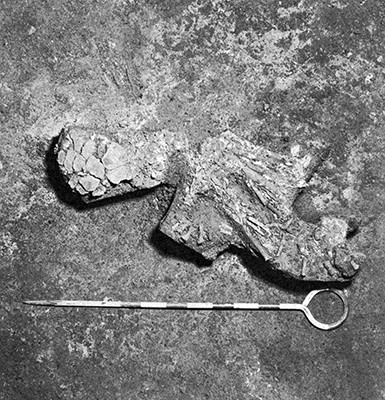
The Shanidar baby, who died at about nine months old, as it was found. It became known as the 'Shandar child' or 'Shanidar 7'.
Many of the fragmentary mammal bones in the same stratum as the child were found in a rotted condition. I had unearthed human skeletons before in archaeological excavations at home, but this was a new experience.
The skeleton was found in a dark-brownish loamy soil. It rested 3 inches above a bed of light grey ashes, probably a hearth bed. The skeleton occupied a depth Of 1.75 inches at its maximum vertical thickness. Search for a burial pit revealed no signs, but there were flecks of charcoal around the bones. However, since these flecks of charcoal appeared elsewhere in the same deposit, no significance could be found in them.
Photo: Solecki (1971)
The infant was found in a flexed, or doubled, position, with its head oriented to the north. All of these bones were found in articulation; the baby had not been disturbed. The foot and leg bones were doubled up to the west, on its right side. The arm bones were similarly flexed. The skull faced upwards. It was badly broken, crushed presumably by the weight of the overlying, soil. All the bones, with the exception of the bones of the extremities, were in a very poor state of preservation. They were friable and rotted, and many fragments were reduced to a powdery state. However, considering the conditions of preservation, we were exceedingly fortunate that so much remained to be recovered.
Originally, the legs may have been doubled upwards, and been twisted to the side under the pressure of the earth. The length of the child's remains measured I foot 3 inches. Their greatest width, across the lower extremities, was 7.5 inches. The arms were poorly defined, but enough bones of the right hand remained to show that the fingers of that hand had been closed, palm upwards. The pelvic girdle and vertebrae were very poorly preserved, and could not be saved. The rib bones had disappeared completely.
The skeleton is represented by eighty-four identifiable bones and bone fragments, including sixteen milk teeth. Careful search around the remains revealed no associated artifacts, with a few possible exceptions. A small block of natural limestone lay at the left heel. Adjacent to the stone was found a small nodule of
Page 102
black carboniferous substance measuring 0.5 inch by 0.75 inch. A large flint was found two inches to the east of the skull, and a fragment of a mammal bone was found one inch to the east of the left knee. Another, smaller fragment of burned bone was found near the right arm. These bones and the flint appear to have been part of the normal occupational layer, and not intentionally placed with the baby's remains. But of this, of course, we could not be sure. It is possible that the limestone fragment and associated substances were burial offerings. The dark mixed loamy soil in which the skeleton was found abounded in occupational matter, including fragments of mammal bones, flints, flecks of charcoal, and other limestone fragments. There was a firebed just about one foot four inches above the baby's remains, but it did not seem likely to have any connection with the baby.
We packed the bones in cotton with great care and placed them in a cigar box which we happened to have in our stores. With the exception of the skull bones, which looked a little too thick, I thought, for a baby, there was nothing really distinctive about the remains. Even though it might not cause much stir among human palaeontologists, it nevertheless represented our first early human find. I put it under lock and key in the strong box.
We were so busy in the cave keeping the work going that no time could be taken out to notify the outside world of our find. It was not until four days later that we could telephone to Dr Naji al Asil of the discovery. The story of the find was printed in Time magazine for 27 July 1953, which carried a companion story on the same page about the Roman excavations at Baiae near Naples. Baiae seemed to have been a place of 'highly questionable reputation'. One of the Baghdad newspapers picked up this particular issue, and somehow cunningly contrived a composite story of the two, in which Shanidar Cave was said to have had drunken Roman orgies and glorious feasts in the past.
We had a fair number of workmen this season, starting off with twenty-one men. Going to work, each man carried a small rectangular shoulder bag suspended by a string, containing his
Season Two: The Shanidar Baby Page 103
lunch. On it was tied his little aluminium tea kettle, pitch-black or newly polished and scoured, according to the owner's inclination. Sometimes a small pot, covered over with a white cloth and containing mastou, was carried in the hand by a string.
In the excavation two ladders had to be used, an 'up' ladder and a 'down' ladder for the constant traffic into and out of the pit. There was always a long line of turbaned figures slowly making their way on the ladders, some in bare feet, and some shod with slippers. I was kept on the move, marking and sacking specimens, measuring, writing notes, and supervising the work without respite except for the occasional tea breaks. Most of my time was spent with the two diggers at the base of the pit, but I had to make frequent trips to the surface to check on the work at the screens, and to change the sacks as new earth came up for re-examination. It was very warm for June, and I gave out salt pills to the workmen to combat the heat. As it was, we occasionally had heat exhaustion cases, even though the men were working in the shade of the cave interior.
Our payroll was running about $120 a week, which made a sizeable dent in the expedition's finances, yet was fantastically low compared with workmen's wages in the United States. Food was correspondingly low, and my food bill for two weeks, including what seemed to be countless chickens, was about six dollars. It was almost like living on fresh air.
We had a number of holidays intervening in the season, which gave us some time for visiting and for explorations. On the biggest holiday of all, the Id feast, we were invited to visit the mudir at Barzan village. The mudir and our representative were old school friends from Baghdad University. This seemed to be a good time for a break in the excavation, since the men were taking a holiday anyway. Moreover, I had heard of a good cave site near Barzan which I wished to see.
On the way we passed the Herki tribal bridge over the gorge of the Greater Zab River. Men were working on it, and it looked to be about two-thirds completed. Both of the spans leading to the rock in the centre of the river were in place, and it lacked only the bridge floor. There were at least three thousand goats, cattle, and horses on the far bank resting and taking water near the head of the bridge.
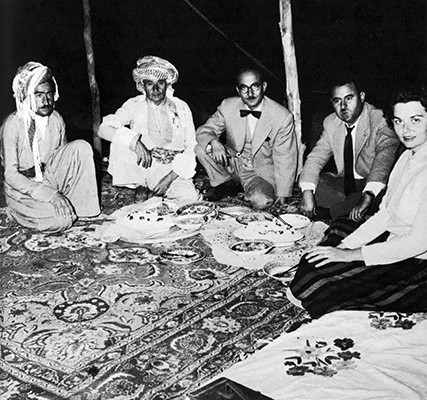
Left to right:
The chief of the Herki tribe in his tent; Shuan Agha, the headman of Shanidar village; Mr Sabri Shukri, our government representative; Taha el Haideri, the qaimaqam (District Commissioner) of Rowanduz (who first told us about Shanidar Cave); and Rose Solecki.
Photo and text: Solecki (1971)
*********************
Season Three: Three adult Neanderthal Skeletons Page 132
The circumstances of the discovery of Shanidar I were as follows: There had been some trouble with loose stones falling into the excavation from Layer A. While this condition was being corrected, it was decided as an additional safety measure to remove a bulge of earth near the top of the eastern wall of the excavation. On the day of the find, 27 April, a rainy Thursday, Philip Smith took a turn with the full labour force to work at Shanidar Cave. At the same time I took advantage of a free day and the services of Michael Mansell Moullin, a hydraulic engineer then employed by the Iraqi government, to survey the Zawi Chemi Shanidar site close to Shanidar village.
In my notes of 27 April I recorded that 'at tea-time, Phil reported the calvarium of a man in the Baradost layer material from layer included Baradostian flints'. The calvarium is the dome of the skull. Smith's notes record the following data:
in afternoon while cleaning off east profile just over B-7, found human skull under rocks at a depth of 14 feet 3 inches. No signs of burial except for thin dark streak on west side of skull. Skull faces south slightly tilted on right side. Large stone resting on top of skull when found [not photographed at this period]. Surrounding earth yellowish brown clayey dirt. Heavy rocks above and all around - possibly the individual was crushed in rockfall, or lay in very shallow grave on which rocks fell. All cranial bones seem present although crushed. Rather heavy brow ridges.
In order to trim the unattractive bulge in the excavation wall, Smith put two of our most powerful workmen to cleaning away some overhanging stones and earth. They took to this task with great energy, recklessly tearing out huge chunks of soil and letting them fall down into the pit. Smith noted this with disapproval and stopped them. He assigned Adai, our Arab Shergati archaeological assistant, who was more painstaking, to this job. The two pick wielders were given another task where they could not harm themselves or their neighbours, or anything in the ground.
The assistant had been at work only about five minutes when at 1-30 pm, he struck a bone with his light pick. Putting this bone carefully aside and taking up his trowel, he cleared an area to see where the bone had come from. As he did this, the
Season Three: Three Adult Neanderthal Skeletons Page 133
rounded top of the skull emerged. This was the moment of discovery. He cleaned it off enough to be sure that it was not a stone, then beckoned to Smith, who had been watching his actions closely, to look at what he had unearthed. It was a reddish-brown dome of bone, with a natural flat, loaf-shaped limestone slab resting on its top rear. The stone was roughly triangular, measuring 10 by 10 inches, and 4 inches thick. There was a thin streak of soil between the stone and the bone. Smith cleaned around the skull, and at the end of the day covered the exposed calvarium with a small hand screen and a burlap sack as protection for the night. Our two night guards were instructed to keep careful watch over the find. When Smith casually mentioned after supper that a skull had been discovered at the cave we were almost unbelieving. For some reason he had kept silent about it until tea-time. Possibly the thought that it was only a Homo sapiens in association with the presumed Upper Palaeolithic Baradostian horizon influenced him. I never did ask him about this.
The following morning, the expedition staff, including Rose Solecki, Philip Smith, George Maranjian, and our guest, Michael Moullin, and I went up to the cave to inspect the find.
The representative of the Directorate General of Antiquities, Sabri Shukri, was away at the time. My initial impression of the discovery as entered in my notes that day was 'A Neanderthal if I ever saw one'. We had a lively discussion about it during supper. It was indeed a very great surprise, as well as a new responsibility. I foresaw that all plans for the excavation at the cave had to be scuttled at once in order to accommodate this new emergency.
When first seen, the top of the skull looked like a small thing perched on the eastern edge of the yawning excavation, lost in the gloom of the huge cavern. It was difficult to realize at first that we had an extreme rarity in human palaeontology before us. It looked like an earth-coloured protuberance at the very end of a narrow ledge in a sheer wall of stones and earth. The whiteness of the limestone blocks and the fragments of rocks around it contrasted sharply with the fresh brown-coloured soils in the section, crisscrossed by pick marks. Seen more
Page 134
closely, and except for the just emergent heavy brow ridge, the skull cap looked like a very soiled and broken gigantic egg. It lay in the south-east quarter of square B-7, at a depth of 13 feet 6 inches from the cave surface at that point, Or 14 feet 3 inches below 'o' datum. The skull faced to the south towards the cave entrance, about 13 metres away. Some broken limestone rocks jutted out near it. A preliminary survey showed that the exploration shaft of my 1953 season excavation had just missed the skull by a scant 10 inches. Such is the element of luck in archaeology.
While it was still in the ground it was very hard to believe that this heavy-browed skull could have belonged to modern man, as would be expected if the find were really in the Upper Palaeolithic Baradostian layer, as recorded by Smith. A recheck of the stratigraphy showed that this observation was in error because of the rockfalls in this quarter. Actually the skull lay in the very top of Layer D, the Mousterian layer.
It was noted that the find lay about 9 feet to the north, slightly to the east, and 2 feet 4 inches above a puzzling collection of then unidentified bones. These were exposed in the north-east quarter of square B-9. They were being cleaned and readied for photographing and drawing at the same time that we were working around Smith's find. The notch or shelf in which the skull lay was barely large enough to hold three people standing in single file. Only one person could conveniently work on the skull at a time.
The skull rested in one of three closely spaced thin occupational soil strata. These lay within a discontinuous thickness of rockfalls extending between the depths of 11 feet 6 inches and 18 feet below 'o' datum at that point. Immediately on top of the approximately 3 foot layer of stones above the skull was a dark-brown loamy soil layer identified as Layer C. it contained heavy occupational evidence, including Baradostian flints. This was the cultural horizon to which Smith mistakenly thought the skull belonged.
Before any further cleaning was done around it, a careful appraisal of the situation was made. One of the first things we did was to station a man on the upper ledge near the find in
Page 135
order to keep any curious workmen from collapsing the dirt on to the skull. The first question before us was how best to expose it fully. It was too hazardous to enlarge the cut because of the heavy limestone blocks above and all around the find. it lay in a pocket of loose, moist, dark-brown sandy loam containing some charcoal flecks. A broad oblong horizontal streak of dark soil was encountered about level with the eyebrows and near the right side of the calvarium. This streak, containing charcoal flecks, may have been part of a rodent burrow, a fairly common phenomenon in Shanidar Cave. Soil samples were taken around the skull as the work progressed.
We naturally wondered how much of the rest of the skull, including the face, was preserved below the eyebrows. Further cleaning resolved this question. The condition of the breaks in the, calvarium. could be accounted for only by a crushing blow on the rear of the top and left side of the head, which burst the sides asunder. All of the cranial bones seemed to be present. It was evident that the blow on the top of the head had caused much damage to the lower part. The nasal bones were broken and bulged outwards. However, even in its crushed state the cranial vault appeared to have a definitely sloping forehead behind a very heavy brow. The skull was canted slightly to the West, although still on an even keel.
We were very much impressed by the freshness of the appearance of the bones. They were dark reddish-brown in colour, with small black mottled patches and specks scattered over the surface. Although the bones were very friable, they were in a fair state of preservation. The soil peeled away very easily from the bones, leaving a damp surface, which dried rapidly on exposure. During the cleaning operation an important consideration for the preservation of the skull became apparent. It seemed that the firm exterior surface of the cranial vault belied the actual thickness of the bone, particularly the crushed part of the left side. There the bone was reduced to almost eggshell thinness because the inner surface of the bone had become detached. Maranjian's careful attention later in the Shanidar laboratory prevented further deterioration of this sort.
Probing around the lower part of the face revealed that the
Page 136
lower jaw, or mandible, seemed to be missing. The mystery was cleared up when a U-shaped row of blunt projections showed up to the left and front of the face. Further cleaning exposed a row of teeth in a chinless massive lower jawbone. A flat stone lay firmly under it. The jawbone or mandible had been distorted, undoubtedly by the same force that had struck the skull. The left side of the mandible had been pushed forwards and inwards. The right ascending ramus or jawbone arch was not seen. We supposed it was still lodged in the cranium. The left ascending ramus was freshly damaged, but the broken piece was there. It was here that the Shergati assistant had initially encountered the remains. This ascending ramus appeared to be fairly broad, and looked unlike any modern human jaw. The appearance of this lower jawbone clinched our first impression that we had a Neanderthal man on our hands.
All of the teeth, with the exception of two medial incisors,
Page 137
seemed to be present. The teeth were worn down flat and fairly even, with no protrusion of the canines. The lower and upper front teeth exhibited curious wear. They were rounded from front to rear. The probable reason for this was not learned until the rest of the skeleton was removed and studied in the laboratory.
We naturally wondered whether the skull was accompanied by the rest of the skeleton. Parts of the postcranial skeleton could be seen projecting out of the earth below and to the east of the lower jaw. Immediately to the east and touching the massive jaw was a slab of flat rotted limestone. The stone lay between the skull and where the rest of the skeleton should be. Further cleaning exposed the neck or cervical vertebrae in the angle between the lower jaw and the skull. What appeared to be a collarbone, or clavicle, jutted out of the earth next to the vertebrae. From the time of the first discovery, the work of cleaning around the skull was entrusted to the staff of the expedition, either Smith, Maranjian or myself.
When fully exposed in its niche on the narrow excavation shelf, the skull made an awesome sight. It was obvious to even the most casual of viewers that this was the head of a person who had suffered a sudden and violent end. The bashed-in head, the displaced lower jaw, and the unnatural twist of the neck were mute evidence of a horrible death. My deduction that this was an ante-mortem, and not a post-mortem, accident is based upon the observation that the head, neck, and lower jaw, although greatly disturbed, still formed a unit, as though originally joined by flesh. The broken bones of the skull vault indicated that a sudden downward compression had caused it to burst at the sides.
It was apparent that the rest of the skeleton must be lying to the east under tons of earth and stones at the same depth as the skull - over 13 feet from the surface. The -uncovering of the postcranial skeleton presented an excavation problem for which two solutions offered themselves. The first was to remove the skull, and then uncover the postcranial skeleton without fear of damage to the skull. The alternative was to seal the skull in place under a protective matrix, uncovering the entire skeleton
Page 138
as a complete unit. The latter method was highly attractive, since, when excavated, the whole skeleton could be examined in situ. However, after considering the possible dangers and risks of this plan, I decided on 28 April to remove the skull before attempting to dig down to the skeleton. In the removal of the overburden some stones would certainly fall down the side of the excavation and possibly cause the wall to slump down thirty feet, carrying the skull down with it. Moreover, although two night watchmen were posted to guard the skull when we were gone, we could never be sure that some curious Kurd might not inadvertently harm the remains. Furthermore, and more serious as a possibility of damage, the necessity of using explosives to remove several boulders above the remains was foreseen. Actually three blasts were set off on 11 May.
In removing the skull the most satisfactory and expedient means seemed to be to take the cranium and mandible out as a unit in a protective cocoon or shell of plaster of paris rather than try to remove each separately. The whole casing, when finished, looked like a huge egg, 2-5 feet long and 1-48 feet in diameter, nestling on the ledge like something left by a prehistoric bird. A strong wooden box was found in the laboratory, and the inside was padded with straw. In this the encased skull was carefully placed. Stout poles nailed on both sides of the box enabled two men on 29 April to carry the priceless burden down the rocky trail to the waiting vehicle for transport to the Shanidar police post.
A saw cut around the circumference of the casing enabled us to lift off the top of the protective covering and to expose the skull. It had been retrieved, soil and all, in the same position in which it was found. George Maranjian, our field physical anthropologist, was given the task of caring for the skeletal remains. He gave the skull painstaking attention, cleaning it, mending breaks, and preserving it from further deterioration,
It was while the skull was exposed in the Shanidar laboratory, sitting in a tub of sand on the table in front of the window, that a small crisis developed. It was not unusual for chickens which the cook had destined for our supper to somehow find their way into the laboratory from the courtyard outside. In one
Page 139
brief unguarded moment one of these chickens had slipped in and made use of the sandbox in which the skull remains rested. We were shocked to see the chicken happily clucking to itself on the window sill, and some of the skull pieces, which Maranjian had been painstakingly cementing together, in disorder. Fortunately, Maranjian found that no damage was done, and the chicken was promptly secured, amid squawks, and given to the cook's care. We could not risk any repetitions of events like this. After that, unless the skull was covered, someone was always present in the room with it.
Now that the skull had been removed we could turn our full attention to the rest of the remains. Before we began to expose the skeleton a number of observations were made on the profile of the cut, and photographs and sectional drawings were made. It was evident that the remains of Shanidar I had been sealed in an occupational stratum between two separate rockfalls. Shortly after reoccupation of the site following an earlier rockfall, perhaps less than a hundred years later, there was another rockfall, killing our unfortunate Neanderthal on the spot.
A grid was extended over the area of the skeleton incorporating four 2-metre squares, and the soil overburden was removed down to the level of the skeleton. After Layers A and B were stripped off, a heavy occupational zone of the Baradostian layer (Layer C) was found to extend to the upper part of the rockfall. deposit which covered Shanidar 1. It was found that the skeletal remains had been covered over with a cluster of limestone rocks of portable size, which in my judgment were placed there intentionally by friends or relatives of the deceased. These stones bore no relation to normal rockfalls, evidences of which we had in plenty. When the first few stones were picked off the heap, it was found that a number of well-preserved but fragmentary mammal bones were scattered among them. There were abundant indications that Shanidar I was associated with the living floor of an occupational horizon. Fragmentary mammal bones, flecks of charcoal and several flint flakes were found in the soil. At least two fire hearths were found just below the skeletal remains.
page 140
As we exposed the skeleton there was increasing confirmation that this individual had been killed on the spot by a rockfall. Bones were observed to be broken, sheared, and crushed in place. Some bones were in direct contact with the stones. Various parts of the skeleton had been crushed upon underlying stones of small size. The force of the stone fall seems to have been greatest on the individual's lower legs, his left hip, and the upper part of his chest. It was noted that the left shoulder was higher than the right, and the left hand and arm lay across the chest. Under field conditions the right hand and forearm could not be seen among the remains. Later, in Baghdad, T. Dale Stewart discovered that Shanidar 1, a male, had an underdeveloped right shoulder blade, collar bone, and upper right arm bone. He believes that Shanidar I was crippled, with a useless right arm, which had been amputated in life just above the elbow. This discovery was something we had never anticipated in the field identification of the skeleton.
My reconstruction of this fatal accident is that the individual had been killed by a rockfall while he was standing on the
Page 141
sloping cave floor, possibly facing to the east. The fall of stones which struck him was a minor wave of a larger ceiling collapse towards the front of the cave. His body was not completely covered with stones, although the impact was forceful. Fortunately also for the preservation of the remains, the soil absorbed some of the blow. If the stones had been larger or if he had been caught against a solid bed of stones, his bones would have been crushed into an unrecognizable pulp. There would have been little left but a thin phosphate layer for the archaeologist to muse over.
A number of stones must have fallen on him within split seconds, throwing his body backwards full length down the slight slope. Presumably the first stones struck him on the head and across the feet and legs. In falling backwards, his body twisted to the right, pinning down his useless stump of a right arm. His left arm and hand, drawn protectively to his chest, were crushed into his ribs and spine. At the same time, a block of stone severed his head and neck from his trunk, and left them in an unnatural attitude. The lower jaw was dislocated to the front and left side of the cranium and broken against a flat stone. There were a couple of small concentrations of mammal bones in association with the skeleton which might have been rodent nests. But it is equally possible that, these bones were dropped there as part of a funeral feast for the dead.
I believe that the survivors of the rockfall returned, and seeing what had happened, heaped some loose stones, the closest at hand, over the unfortunate's remains. Some of the loose mammal bones lying on top of and among these stones may have been part of the funeral feast. Eventually, a few inches of occupational deposits accumulated over the heap, followed by another rockfall, which sealed off the Mousterian deposit in this quarter. Thus ended a people and an age at Shanidar Cave.
Although,he was born into a, savage and brutal, environment Shanidar I man provides proof that his people were not lacking in compassion.., According to Stewart's findings, he was an individual who lived to the relatively old age of forty years, a spry old man for a Neanderthal - equivalent to a man of about
Page 142
eighty today. He was plagued by arthritis, which seems to have been a rather common ailment among Neanderthals - and no wonder, considering the kind of life they led. As a case of rehabilitation, Shanidar I was a prime example. Not only did he possess a disability from the day he was born, but he must have been blind in the left eye. Stewart's examinations disclosed
That the right arm, collar bone, and shoulder blade had never fully grown from birth. Furthermore, there was extensive bone scar tissue on the left side of his face. And as if this were not enough, there is evidence that the top right side of his skull had received some damage which had healed well before the time of death. In short, Shanidar I - or 'Nandy', as we called him around the dinner-table - was at a distinct disadvantage in an environment where even men in the best of condition had a hard time. He could barely forage and fend for himself, and we must assume that he was accepted and supported by his people up to the day he died. Any manpower must have been an asset to this ancient little community, especially since it undoubtedly took group activity to hunt the gregarious beasts of the wild. That 'Nandy' made himself useful around the hearth (two hearths were found very close to him) is evidenced by the unusual wear on his front teeth. It presumably indicates that in lieu of a right arm, he used his jaws for grasping, while manipulating with his good left arm and hand. The stones over his remains, and the mammal food remains, show that even in death his person was an object of some esteem, if not respect, born out of close association against a hostile outside.
As the bones were exposed and cleaned of earth, they were coated with a solution of Nicol cement, almost to the sorrow of Dr Stewart. He told us later that he would rather have had the bones in a dry state, since all of the cement had to be tediously cleaned off before restoration and piecing together of the bones could be attempted. However, the field conditions dictated that some kind of bonding agent must be applied to the bones then and there, so that they would not fall away to powder. This coating was applied principally for transporting the postcranial skeleton. Since our field observations on the remains in situ could never be as thorough as under controlled
Page 143
conditions in the laboratory, it was thought that the entire skeleton should be removed en bloc. Each separate bone could then receive the attention it required, and the whole skeleton could be studied at leisure. I therefore decided that we should encase the skeleton as it lay. Since the feet and adjacent parts appeared to form a reasonable-sized unit, 1 decided that we should make them into one separate package. The body proper, including the lower limbs, made another unit of what I thought should be manageable size. After the bones had been thoroughly coated with a protective film of cement, we packed a sheathing of cotton and waste over the bones. Over this, we put successive strips of burlap cloth soaked in plaster of paris. For rigidity and strength, a frame of wood and lath was put over and around the skeleton. After the top of the skeleton was covered sufficiently, we undercut the remains, adding successive strips underneath. A number of stones were encountered below the remains and had to be included in the casing.
In this manner, the body of the skeleton was encased in one block, and the feet in another. The removal of the feet was a simple matter; that of the larger casing was quite another. We did not know it then, but the large casing weighed nearly half a ton. It took the combined strength of seven men to raise it to the top of the excavation. In this wise, 'Nandy' saw the outside world after some 45,000 years in his mountain-cave home.
The following day, 31 May, a team of eight men was organized to carry the larger cast down the trail to the waiting vehicle. A four-poled rig of tree limbs was formed into a sort of suspension carriage, two poles on either side of the cast. A man was positioned at the end of each of the poles. It looked like the prototype of a knee-action vehicle. The men had gone no more than fifty yards down the trail when it became obvious that more manpower was needed. I had to send out into the farm fields to impress five more men into service. The portage went easier with the larger crew, since a fresh person could take the place of a faltering carrier.
The casings of Shanidar I were boxed that night, and at 5.30 AM on i June left the Shanidar police post by lorry for the railroad station at Erbil, about seven bumpy hours away.
**********************
Page 176
...........In some cases the pollen appeared to be resting inside the anther, or pollen-bearing part of the flower. Mme Leroi-Gourhan deduced that no accident of nature could have deposited such remains deep in the cave. Neither birds nor animals could have carried flowers in such a manner in the first place, and in the second, they could not have deposited them with a burial. Finally, one species of flower, the holly hock, a very large, pretty flower, grows in separate, individual ,stands. Therefore she concluded that someone in the last Ice Age had ranged the mountainside in the mournful task of collecting flowers. The soils from the area immediately border ing the grave did not yield any evidence of flowers. This provided an additional check on the finds.
The two samples rich in flowers, Nos. 313 IV and 34 IV, were taken from about the same level on which the skeleton lay. This was probably part of a funeral bier or preparation of some kind. A third sample, No. 304 IV, less rich in flower pollens, was collected at the heel bones. This marked a triangle of flower-pollen-bearing soil samples around the skeleton. humid soil may have- had something to do with the good preservation of the pollen.
At least seven species of flowers are represented by the pollens. One species of flowers is represented by random or isolated pollens in an unusually high number. These flower families are still to be found in the geographic area of Shanidar today.
Mme Leroi-Gourhan has identified the most numerous of the flower clusters as: Compositae family: Achillea type, Centaurea type (C. solstitialis), Senedo type; Liliaceae family: Muscari type; Gnetaceae family: Ephedra altissima. The pollen clusters from two other species, in spite of their quantity, could not be identified.
The Composites are collectively known as the daisy family. At least six species of the genus Achillea are identified in the Shanidar geographic area. Its common name is yarrow, or milfoil, a flower widely used in herbal medicine in the past and for application to wounds. 'Yarrow' is a word derived from the Anglo-Saxon, meaning 'healer'. The Centaurea solstitialis L.
page 177
is a flower commonly known at St Barnaby's-thistle. It is a white cotton leaved plant with rounded heads of pale yellow flowers and long yellow spikes that spread defensively outwards from the head. It is not a very inviting flower, but it has its uses today in herbal remedies and is eaten as a vegetable. The genus Senecio is represented by at least four species in northern Iraq. Of these annual groundsels, Senecio vernalis W. and K. have relatively large and brilliant yellow flowers. The name 'groundsel' comes from the Anglo-Saxon meaning 'pus swallower', undoubtedly because it is used in poultices. During its long flowering season, which lasts until late spring, this flower produces a great quantity of fruit.
Of the family Liliaceae, the Muscari, or grape hyacinth, is a very lovely flower with a dark blackish-blue colour. At least four different species of this genus have been identified in northern Iraq. They are purely ornamental flowers.
The genus Ephedra is included in the group called 'jointpine', or 'woody horse tail'. The flowers of this type are small and not so conspicuous as the others, but they have ramose branches that lend themselves to - the fabrication of a network or bedding. At least one of the species found elsewhere in Iraq is used for medicinal purposes.
The Malvaceae family is represented in the pollen samples by the genus Althaea, identified by Mme Leroi-Gourhan as hollyhocks. This is a distinctive plant with a tall, wand-like stem and large flowers. Unlike the other pollens, the Althaea type Pollens do not occur in the grave as clusters, but as random isolated pollens. However, they occur in an unusually, great number here, more than the normal amount in other cave deposit samples. From the hollyhock roots, leaves, flowers aria seeds, or practically the whole flower, a variety of medicines with a great many uses can be made. These range from relief from toothache and inflammation to uses as poultices and for spasms. It seems to be the poor man's aspirin.
We do not know if the Shanidar Neanderthals were aware of the medicinal properties as well as the ornamental properties of flowers, but it is likely that as working naturalists they must have given all living plants a taste during some time in their long existence. Until we know a little more about flowers in antiquity, it would be asking too much to believe that the Neanderthals were cognizant of the medicinal properties of flowers.
Taken altogether, these flowers from the Shanidar grave certainly- do not look like the ornamental group one familiarly finds in the home parlour: Of course, we cannot account for the tastes among the Neanderthals; moreover, they gathered what was in season. From the botanical evidence, Mme Leroi-Gourhan believes that the placement of the Neanderthal IV on a bed of woody branches and flowers took place sometime between the end of May and the beginning of July. Missing are the exceedingly brilliant red anemones and other lovely bright flowers that abound on the Shanidar hillslopes earlier in the spring.
From archaeological findings elsewhere we already know that Neanderthal man seems to have had a spiritual concept, since he evidently practised funerary rites over his dead. But the occurrence of flowers with Neanderthal burials raises the question 'Where else in prehistory is there any parallel?' Searching through the literature on Stone Age cultures yields nothing, with the apparent exception of an image scratched in bone, which is interpreted by Marshack as a flower in bloom. None of the voluminous books on cave art sheds any light on the matter. The depictions in caves are concerned mainly with the food animals. On the economic uses of plants in prehistory there is a growing wealth of information, but on flowers there is silence. With the finding of flowers in association with Neanderthals, we are brought suddenly to the realization that the universality of mankind and the love of beauty go beyond the boundary of our own species. No longer can we deny the early men the full range of human feelings and experience.
References
- Solecki R., 1971: Shanidar: The First Flower People, Knopf, New York (1971).
- Trinkaus E., 1983: The Shanidar Neanderthals, Academic Press, Inc.
